Probably a long, rambling nature post... come along if you'd like!
So this post includes pictures from yesterday's walk at the lake... not very many, since a thunderstorm showed up, and pictures from today's walk in the woods around my house. Honey was a bit concerned about me wandering around the woods, since we currently have a rather alarmingly outgoing black bear in the area who likes to sit in his parents' yard and watch them through the windows and also likes climbing into our "bear-resistant" dumpster and wandering up and down the driveway. I was not concerned. In the entire decade from 2000 to 2010, there were 16 deaths caused by black bears across their entire range of most of the USA and most of Canada, and of those, several were captive bears and people were being stupid, several were people who had been deliberately feeding bears, and several others were bears in remote areas who were not used to humans and might have been scared by them. Attacks in areas where black bears live in proximity with humans are basically nonexistent, which is why wildlife officers very rarely seem concerned about relocating them. They are, for all intents and purposes, very large raccoons. Like raccoons, they are capable of being very nasty if you have one in a trap or otherwise cornered, but will nearly always take the option of going elsewhere over the option of possible conflict. Excessive fear of black bears creates dangerous situations where people try to run from them or shoot them instead of just standing there yelling and waving your arms. Black bears have no idea what to do with a loud, weird creature making noises at them, so they usually go away. Running from them can trigger a hunting instinct, just like with dogs.
ANYWAY.
I did not see the bear today, although he was out dumpster-diving yesterday.
I think I DID, however, solve the mystery of this bizarre flower-looking fungus...
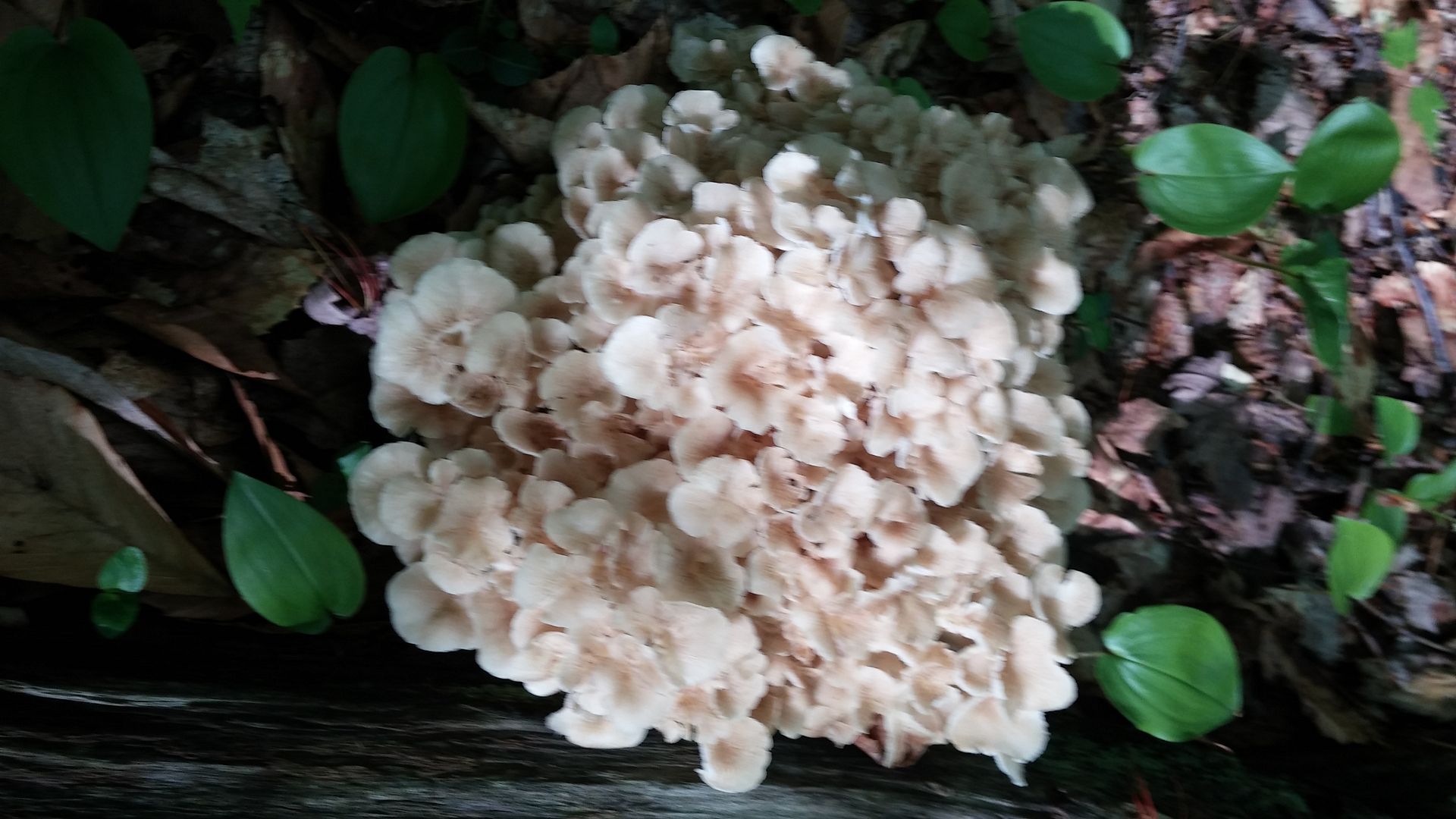
While it's a shame I didn't get a better picture, I believe it's a very young Grifola frondosa. My European friends would not recognize them because they are native only to parts of the USA and to Japan, where they are called maitake. I think the reason I've never found one before is the same reason I never find any morels or chanterelles... this is a very highly desirable edible mushroom and is considered to have medicinal properties. It can get very large and can be sold for a decent bit of cash. I suspect mushroom hunters are active in the state park area around the lake and harvest most of the edibles before I get to see them. I don't think mushroom hunting on state park land is illegal, but even if it was no one would bother to stop them.
I returned today and found it looking like this.
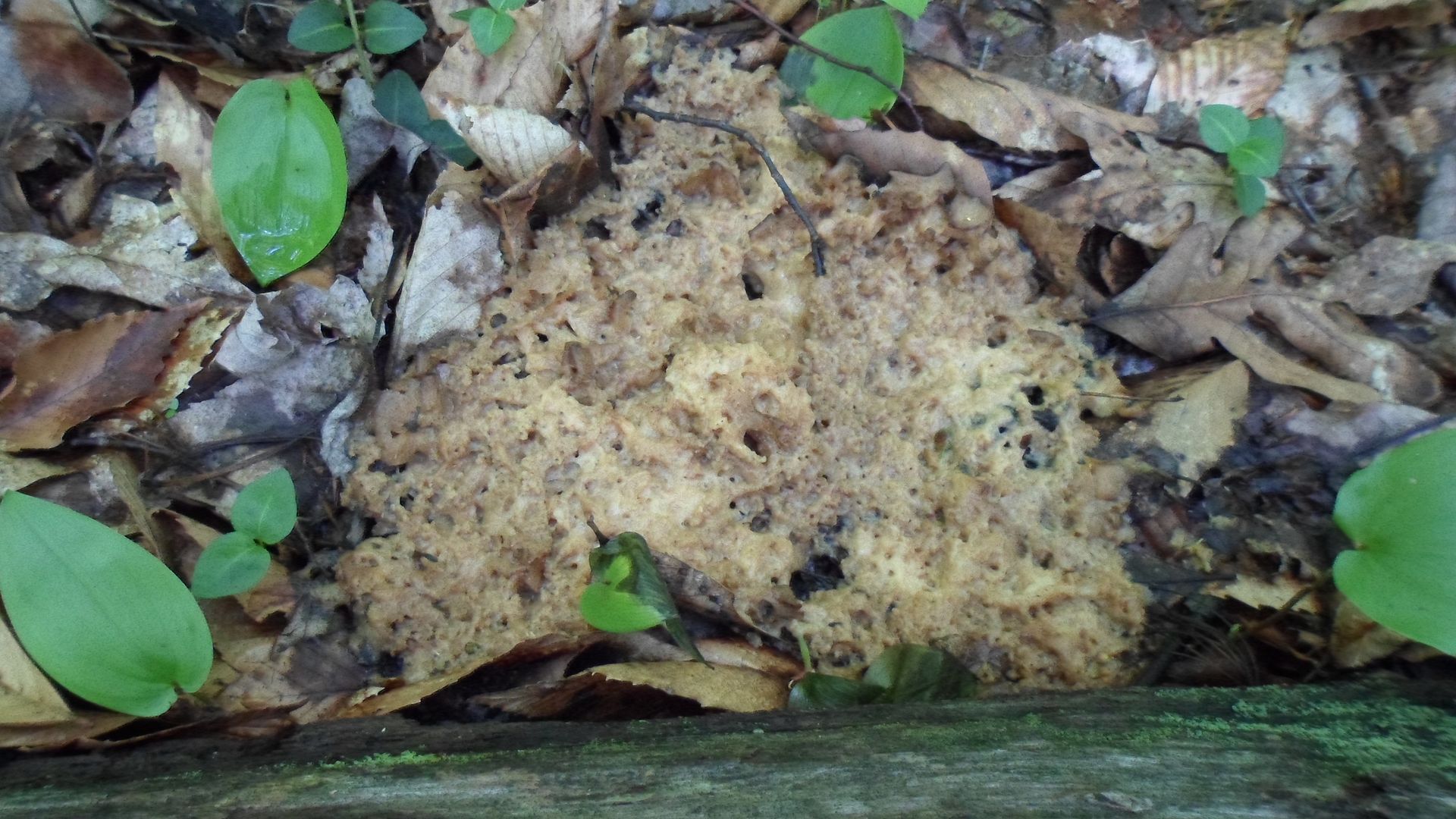
I am not at all certain of this identification but it was the only thing even remotely similar that I found. To be that white and delicate it would have to be a very young one, and it looks like flies and high humidity did it in before it could get any bigger.
ANYWAY.

Meandering around the lake... some more beautiful blue irises/flags/whatever you prefer to call them. The blue ones seem particularly tolerant of wet places... they may be a subspecies or slightly different species from the ones you see in gardens and roadsides.
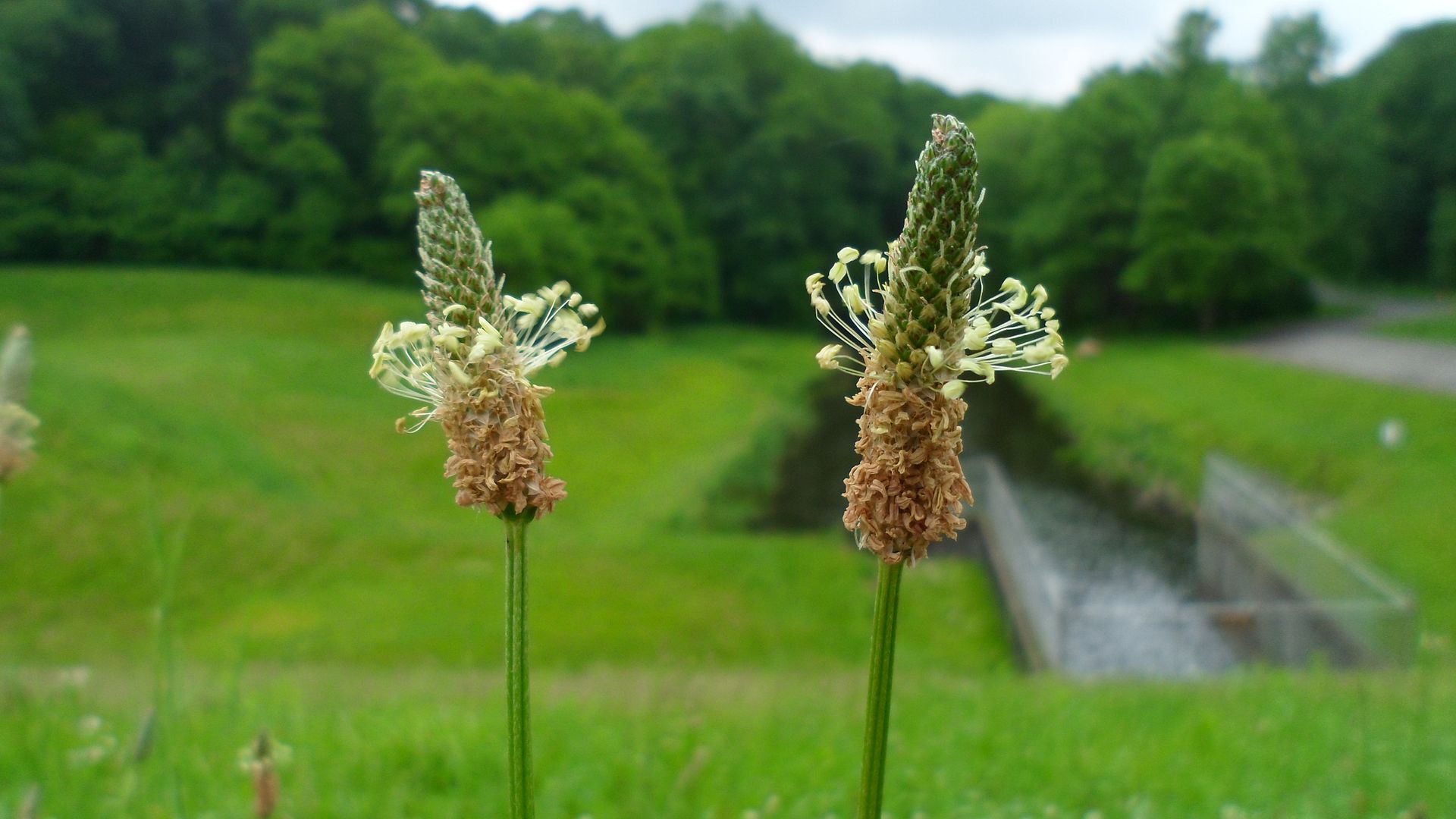
Narrow-leaf plantain, Plantago lanceolata, an invasive weed from our English settlers, exceedingly common and so familiar almost no one would believe you if you told them it didn't belong here. I like them... they don't really seem to do any harm and their little flower heads are fascinating. The flowers bloom starting at the bottom and moving to the top, and are wind-pollinated, so their habit of not blooming all at once may be an adaptation to avoid self-pollination (some plants are quite happy to self-pollinate but most have some mechanism to avoid it if possible as it lowers genetic diversity).
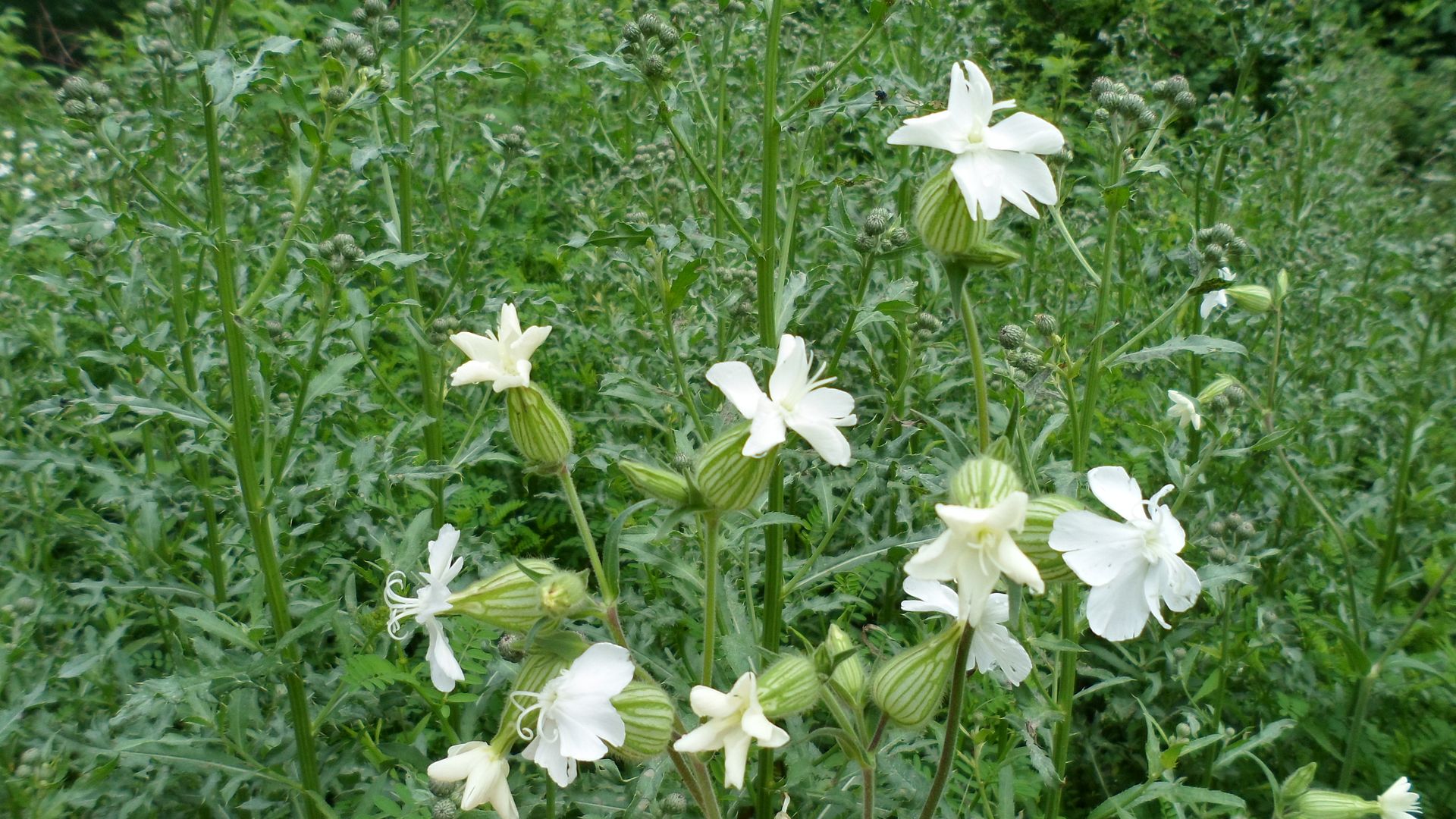
Some more of those lovely white campions from the other post, the ones that apparently in England are known for growing around gravestones. These ones are growing in a partly-shaded patch, which is why they are only partly open (in unsuitable weather they will close up completely).
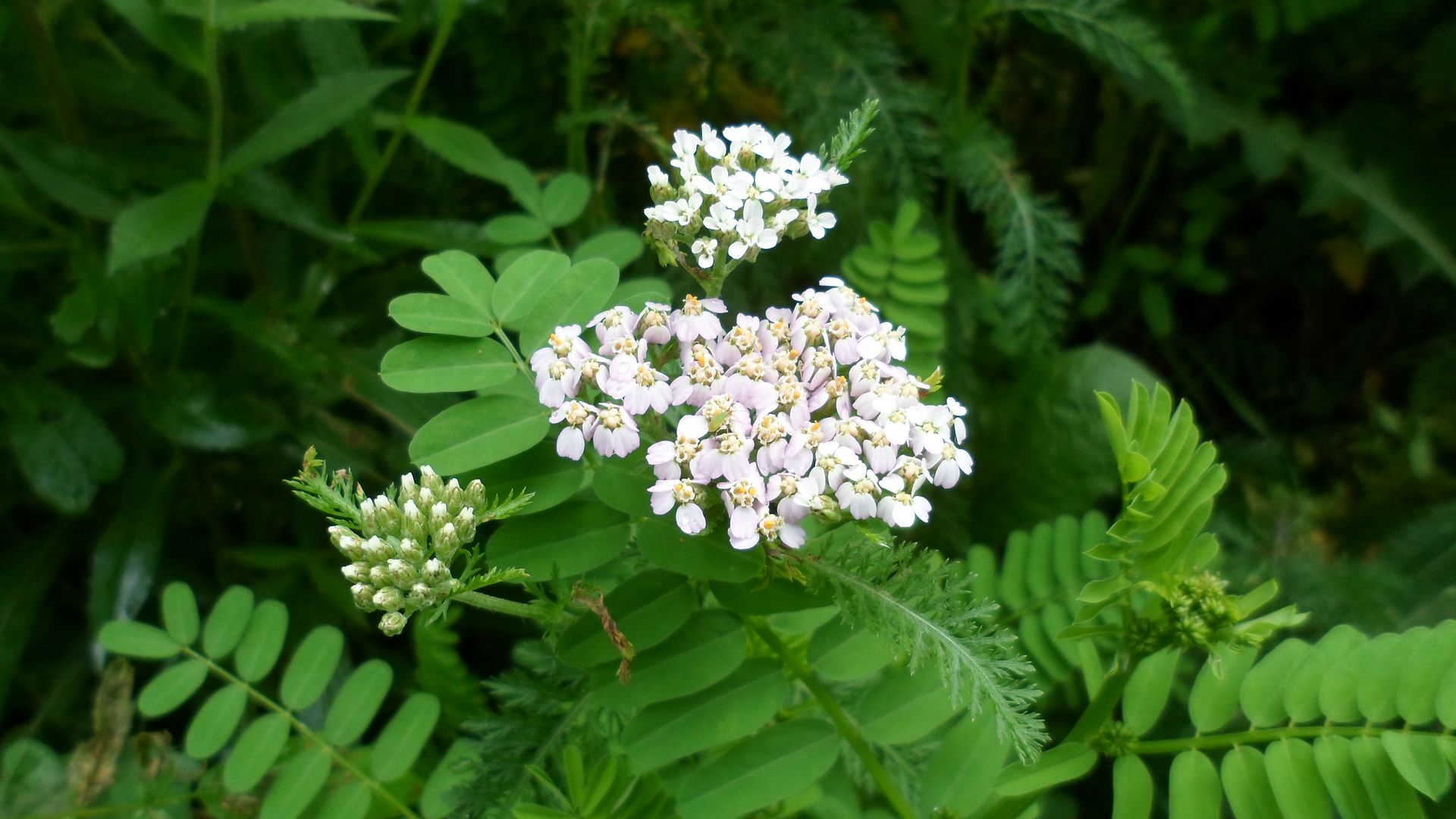
Yarrow is well-known to many people as a medicinal herb or just a pretty wildflower. This is the first one I've seen this year. And only the one feathery leaf belongs to the yarrow... the compound pinnate leaves (well, that's what they're called!) belong to crown vetch.
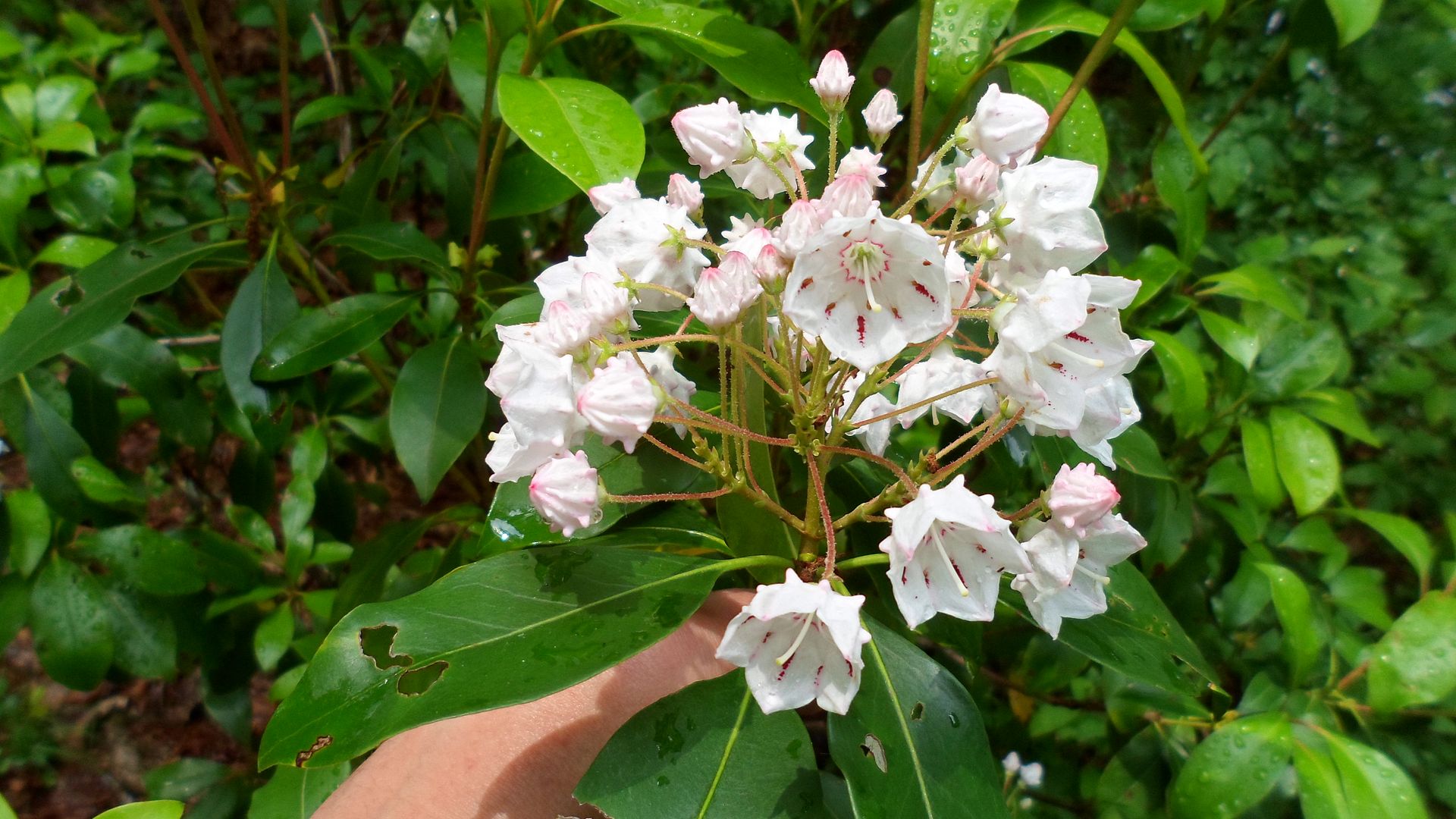
The mountain laurels are blooming! These are among my favorite early season flowers... the markings inside are stunningly beautiful, although only noticeable if you look closely. They are beautiful enough to make them the official flower of several states/provinces. The markings are a guide for pollinators, important because the flowers are not long-lasting and in cold climates where they like to grow, bees can still be a bit lazy this time of year.
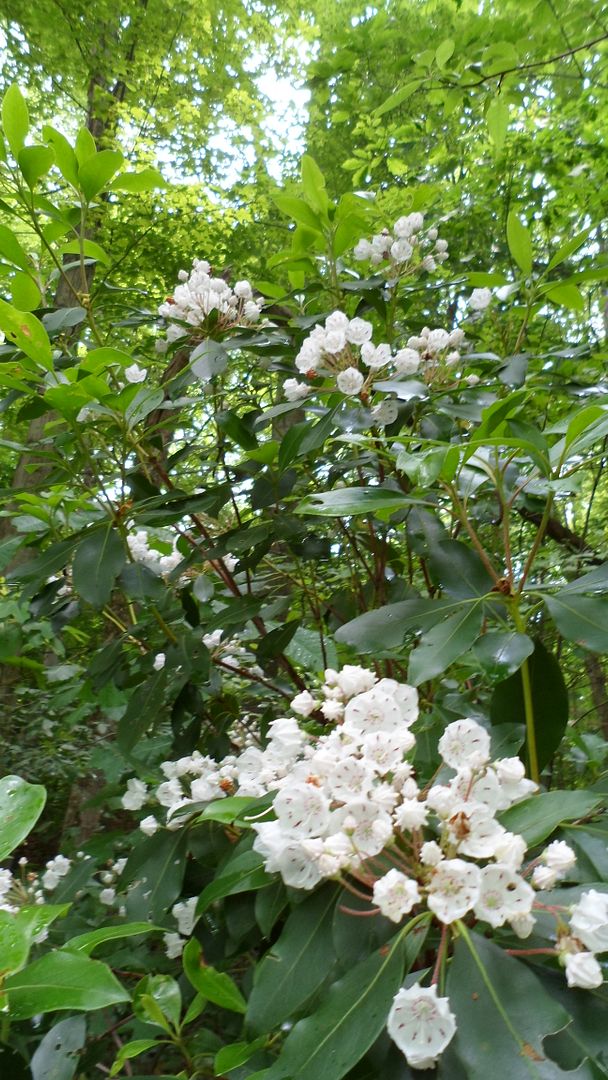
Beautiful, beautiful clusters of flowers on all the mountain laurels. I don't notice much of a fragrance, but their relatives such as rhododendrons don't have a strong scent either, and may rely on markings or bold colors (or being the only things around and blooming for hungry bees).
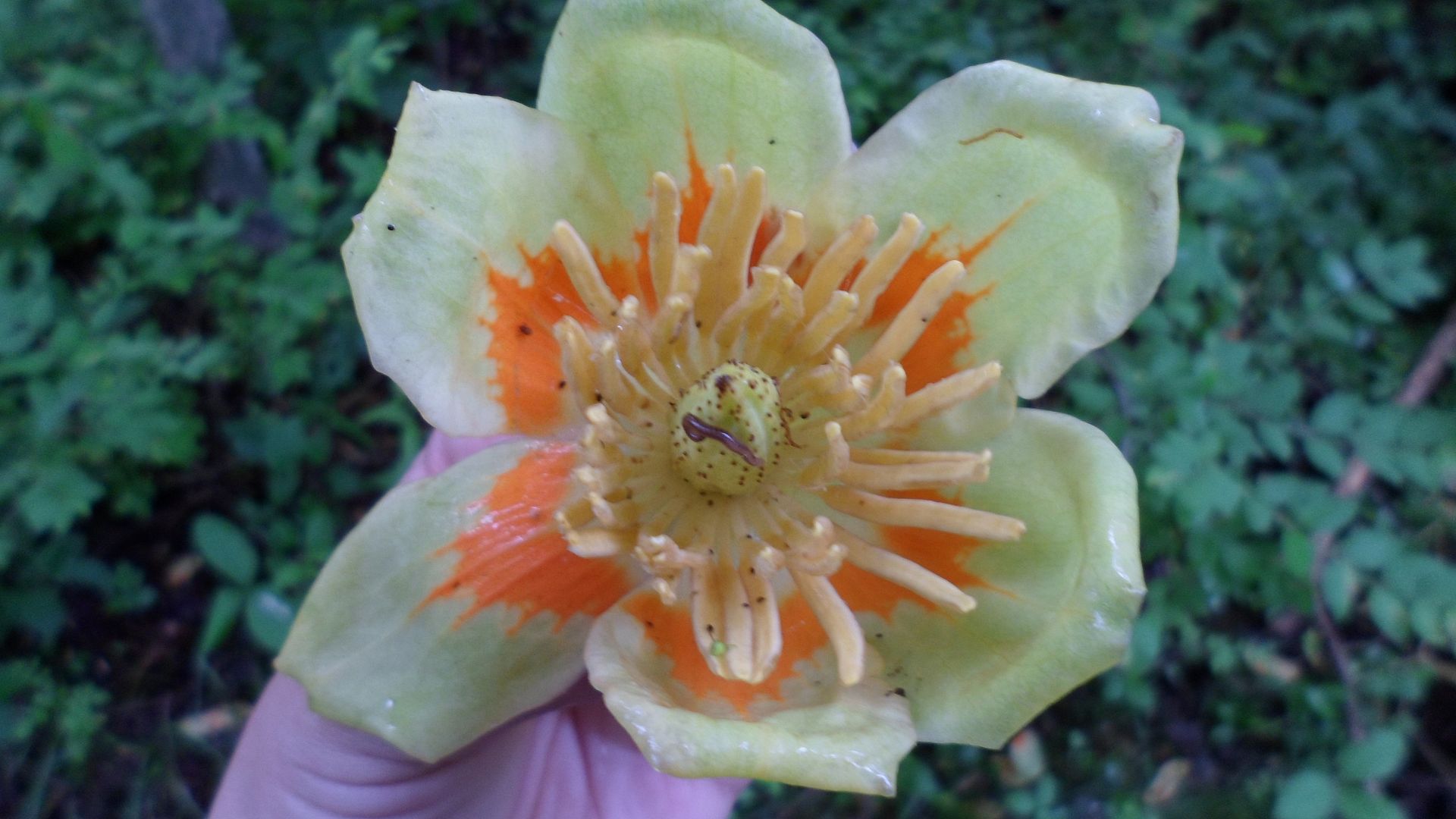
Finally found an intact (if slightly damaged) tulip tree flower for you. Considering how far it fell (I couldn't even SEE the tree it fell from, because it was so much taller than its neighbors), it's impressive to find one that's not in pieces. It is a bit faded; the "petals" (not really, but whatever) are usually greener. Despite not having proper petals, it has all the equipment a flower usually has. The rounded spike in the center will become covered with seeds that develop at the base of a thin sort of wing that helps them disperse from the parent tree; the end result looks something like a soft and very compact pine cone. SOMETHING collects them and makes huge piles of them in our woods but we cannot figure out what is doing it.
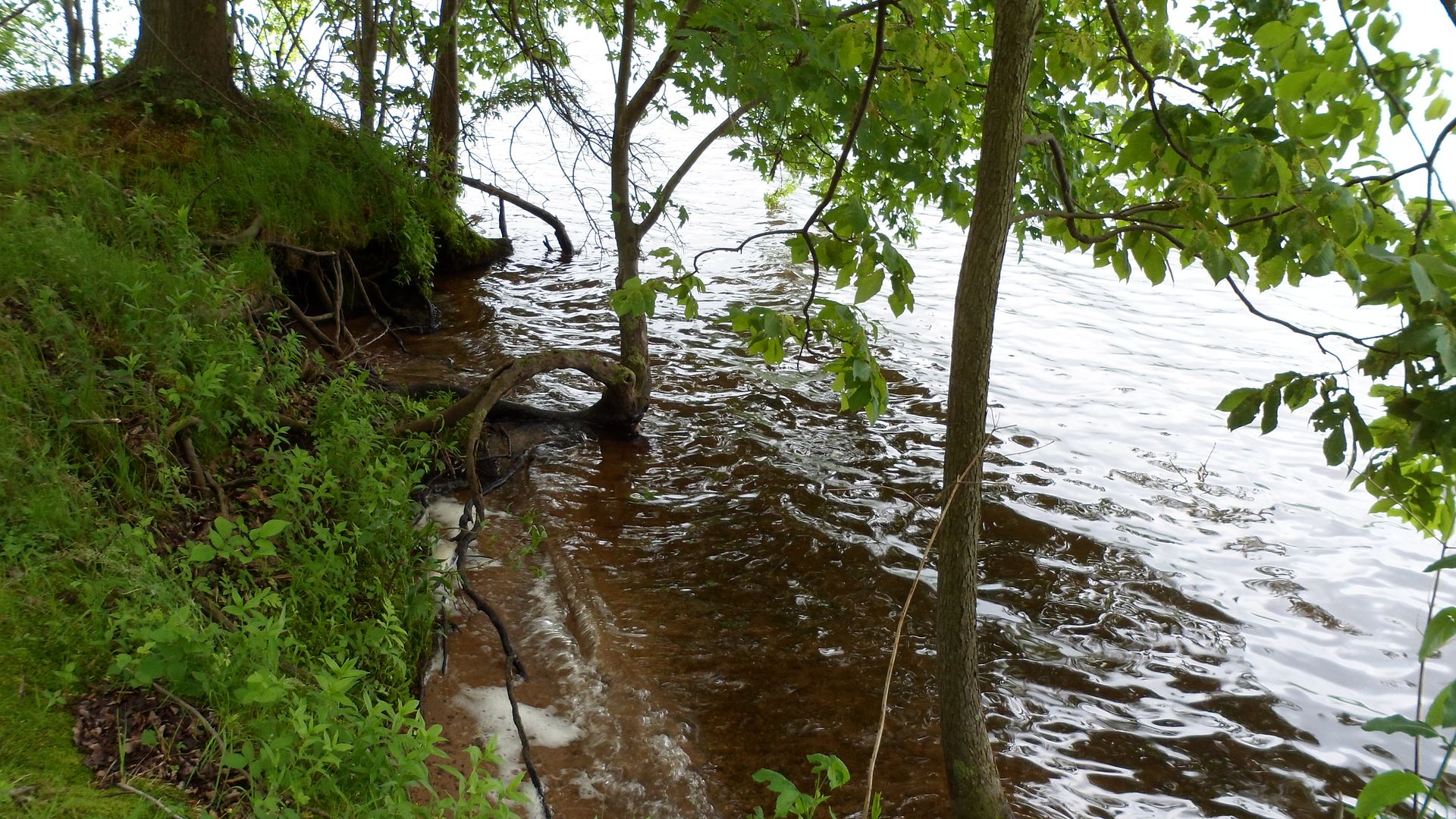
Wandering off the trail I found this pretty shoreline...
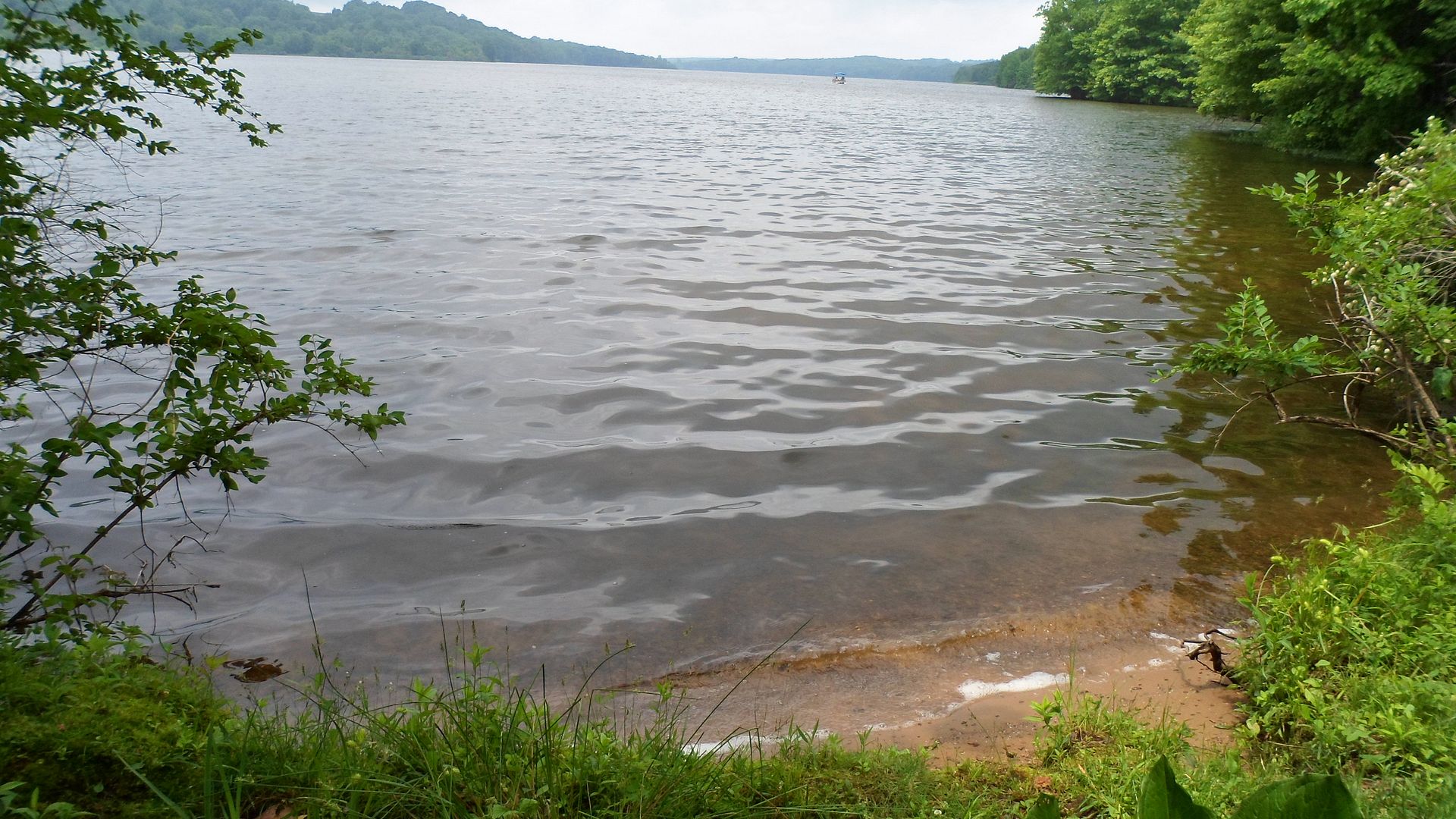
And this tiny mini-beach all to myself. Unfortunately I had to share it with several VERY dead fish and decided not to stay.

In the unpleasant-spiky-things category, this is Carex lurida, also known as shallow sedge and leave-it-the-hell-alone. It's actually not as nasty as it looks. There are lots of sedges but this one likes muddy or boggy shorelines.
Just when I had given up all hope of finding mushrooms... even my best and most reliable locations had given me nothing... I found this one, which someone or something had VERY recently knocked over...
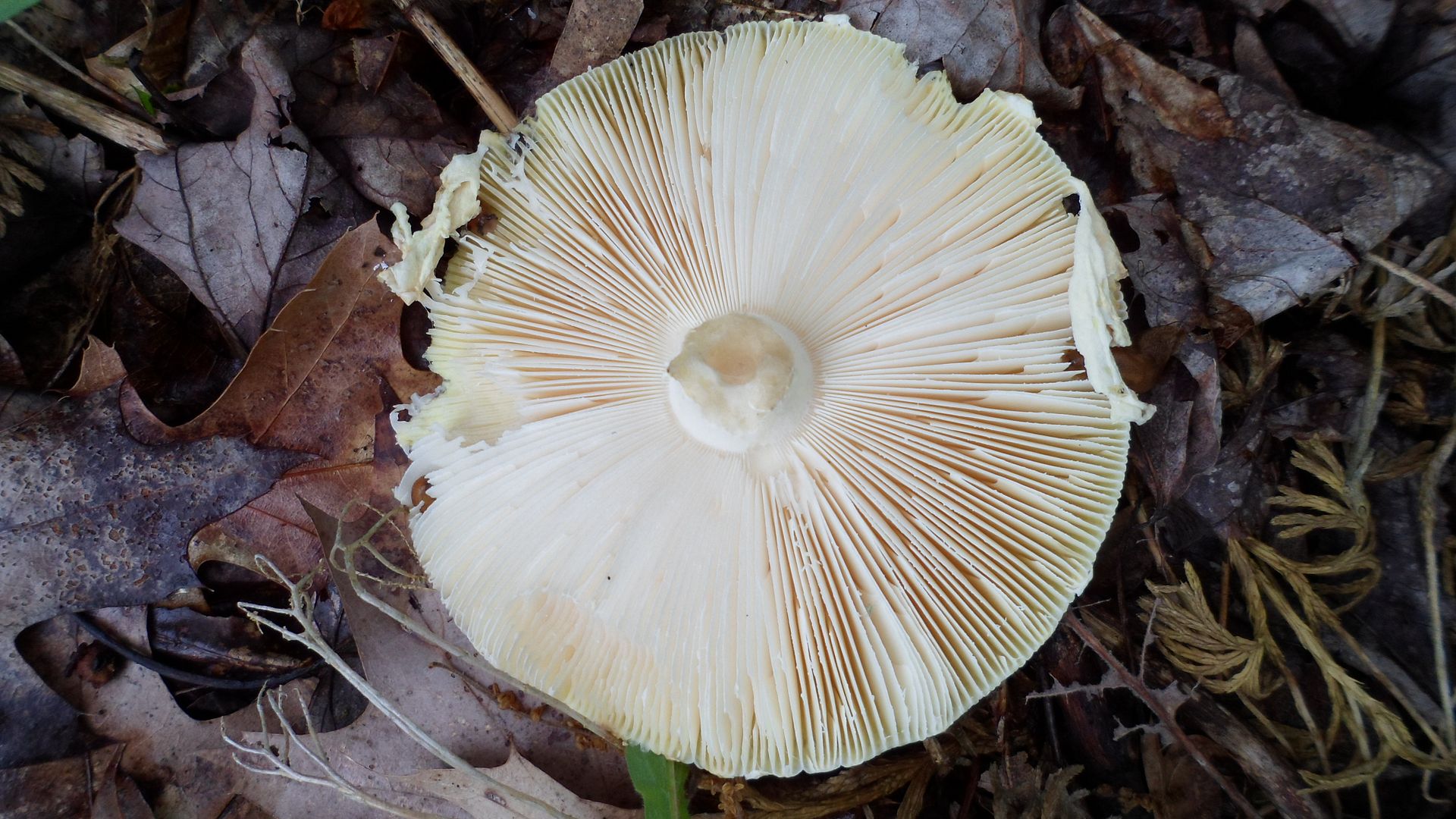
I love mushroom gills. They are amazingly perfect and organized... the spacing has to be very exact to allow for maximum spore dispersal, since the spores develop on the surface of the gills.

Since it looked very, very fresh and NOT covered with maggots, I picked it up... and lo and behold, the season's first fly agaric, and a stunningly beautiful one (the yellow color morph is much more common here than the red one of classic fairy tale mushrooms). It can't have been on the ground longer than a few hours, to still look so fresh. The upper surface had a slightly tacky texture, like half-dry paint, but a bit more slippery. The bits stuck all over it are remnants of the veil it hid in as a little budding mushroom underground.
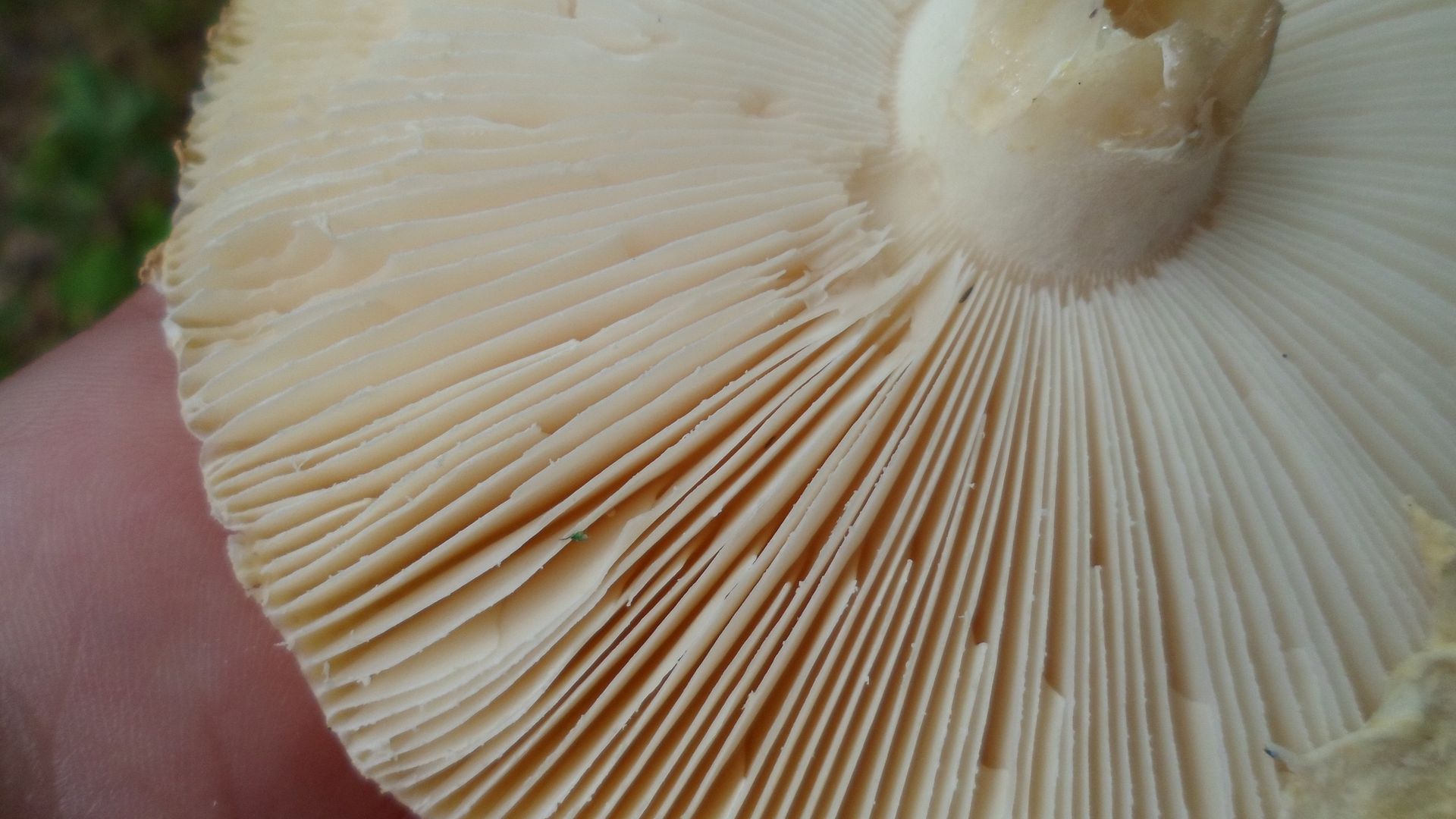
Unlike the texture of the top, the gills are amazingly soft, almost buttery soft, and feel like velvet brushed against your hand. If you could look very closely, you would see clusters of microscopic spores developing and then falling free (often weighed down by a micro-droplet of water). The gills are perfectly designed to allow the spores to fall freely. Touching them is almost hypnotic and I could have spent an hour sitting and brushing my fingers over them, the amazing softness and delicate ripples beneath my fingertips. However, since this species is poisonous (not terribly so, but enough to make you feel sick and enough not to want to eat it or probably rub it all over yourself and then accidentally get it in your mouth, so I reluctantly decided to stop petting it.
Back on home turf...
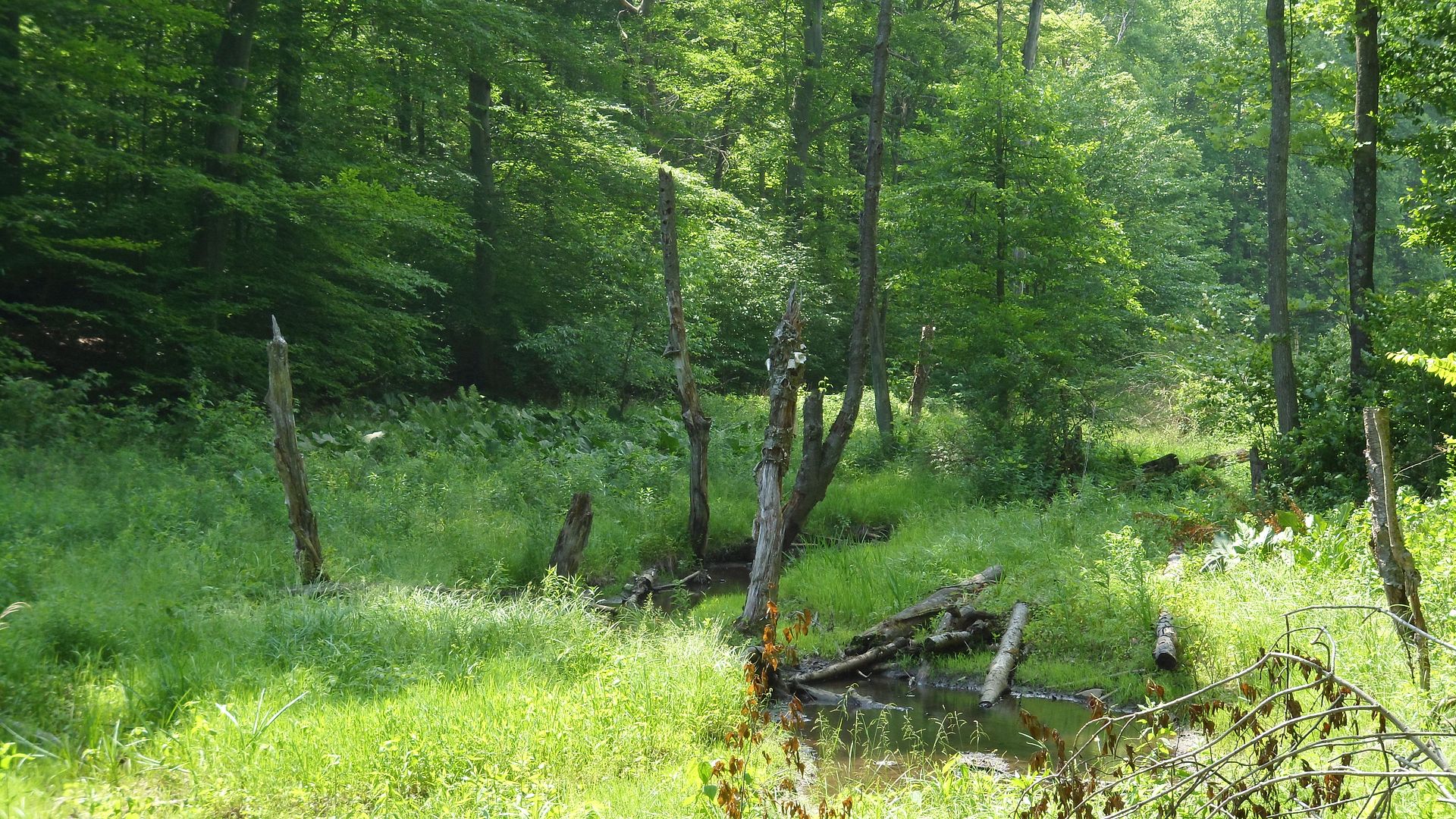
I've shown you pictures of the completely barren, muddy, flattened area where the beaver pond was... but before the beavers built THAT pond, they had another one, farther downstream. This is the floodplain of THAT beaver dam, many years older and with time to regrow its grassy swamp flora, although it's still studded with dead trees that did not appreciate suddently finding themselves in the middle of a pond. Because they were several feet underwater, they were not immediately attacked by fungi and some of them still seem to be ignored.
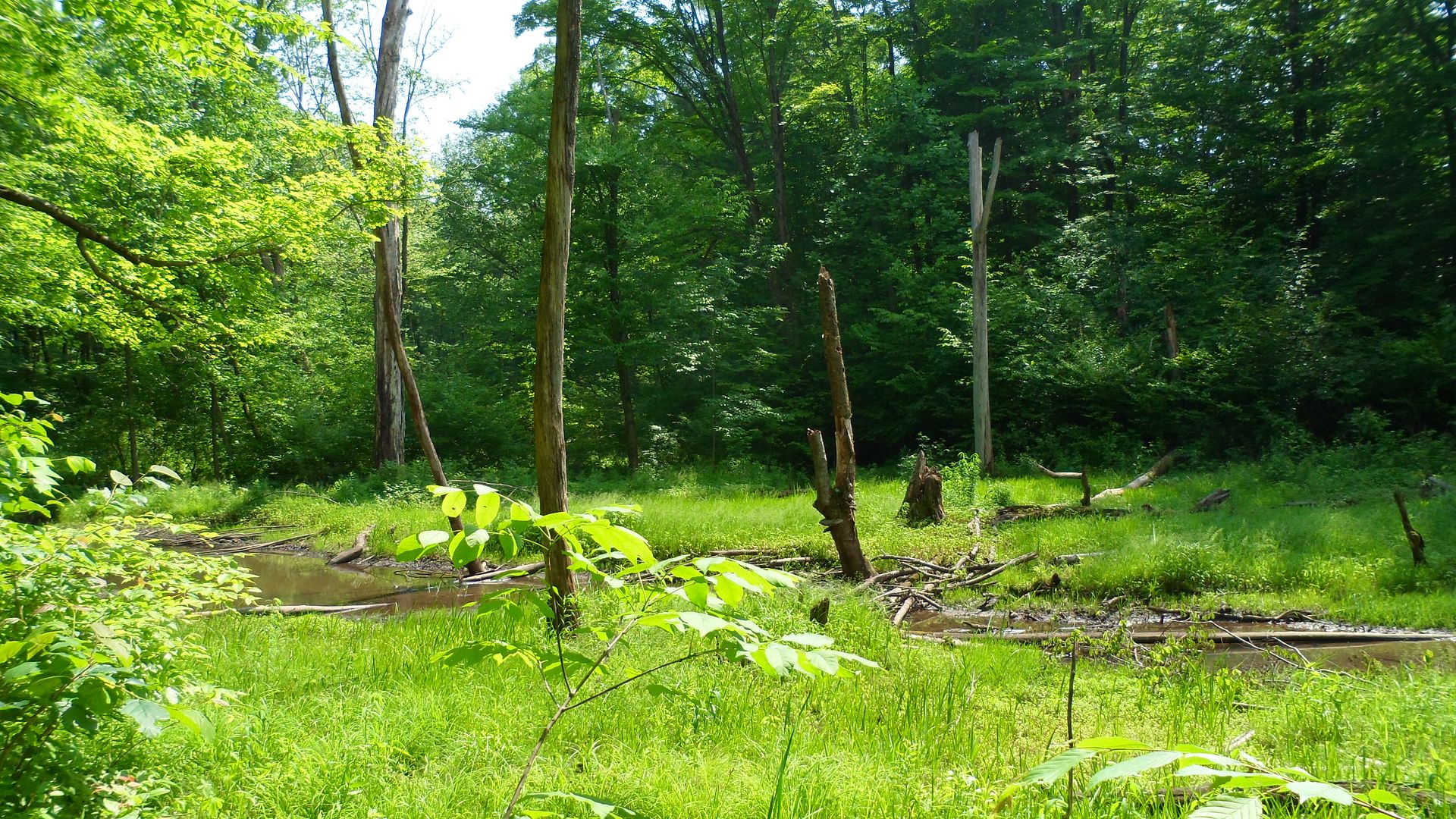
This is probably what the current barren-looking mess of the recently emptied beaver pond will look like in ten years or so... lush growth that tolerates the swampy ground cut through with endless tiny runoff creeks, dead trees standing as reminders of the past, new saplings testing their feet in the still-unstable ground which is made up of the muddy silt that accumulated at the bottom of this former pond.
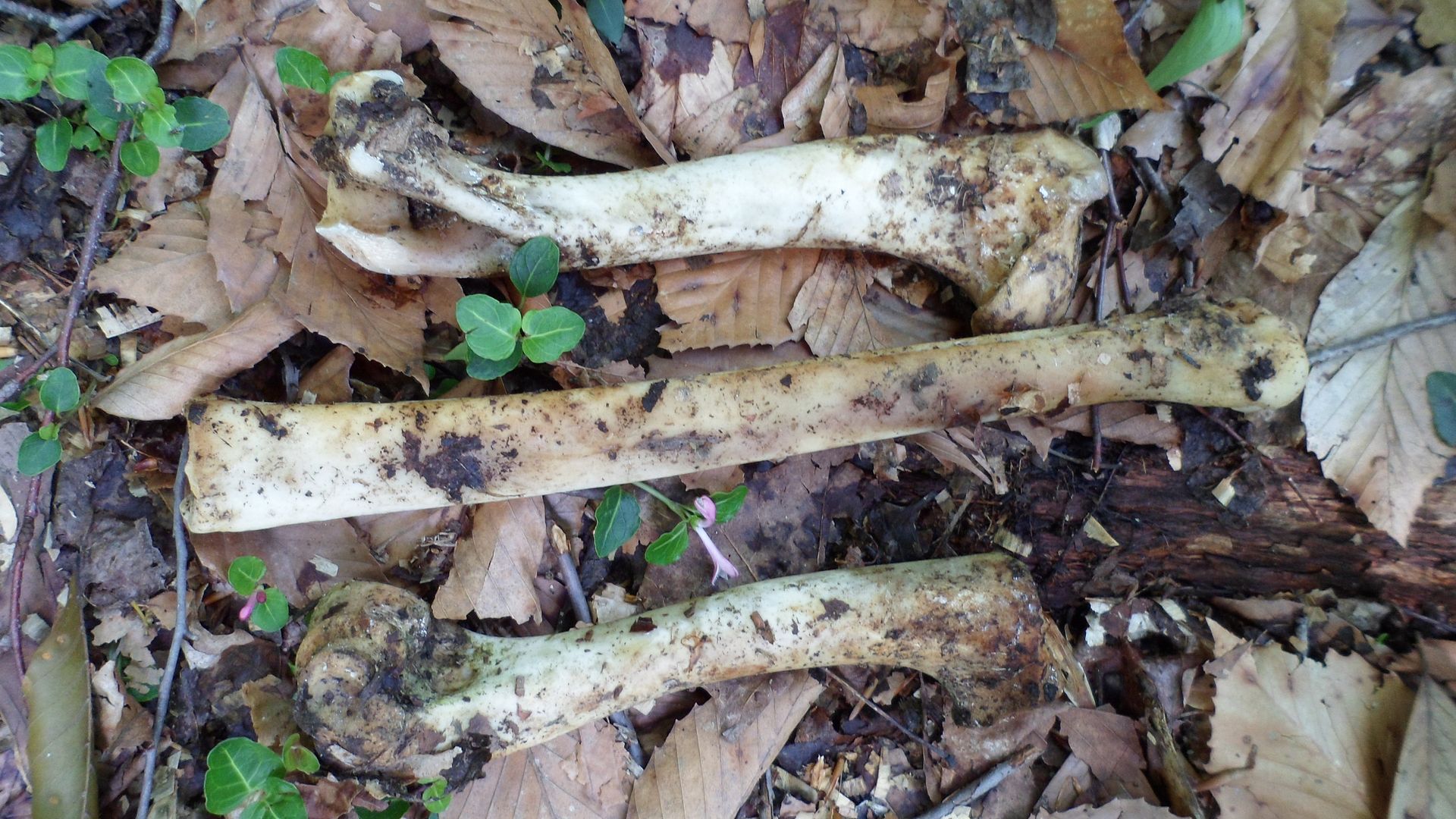
Some bits from a deer that I found near the mud... these could be from a natural death instead of from one hunted and processed for food... when they butcher the deer for meat there is usually some sawing through the long bones of the legs since they have basically no meat on them whatsoever and get in the way of the rest of the work. These ones have no cut ends and no knife marks.
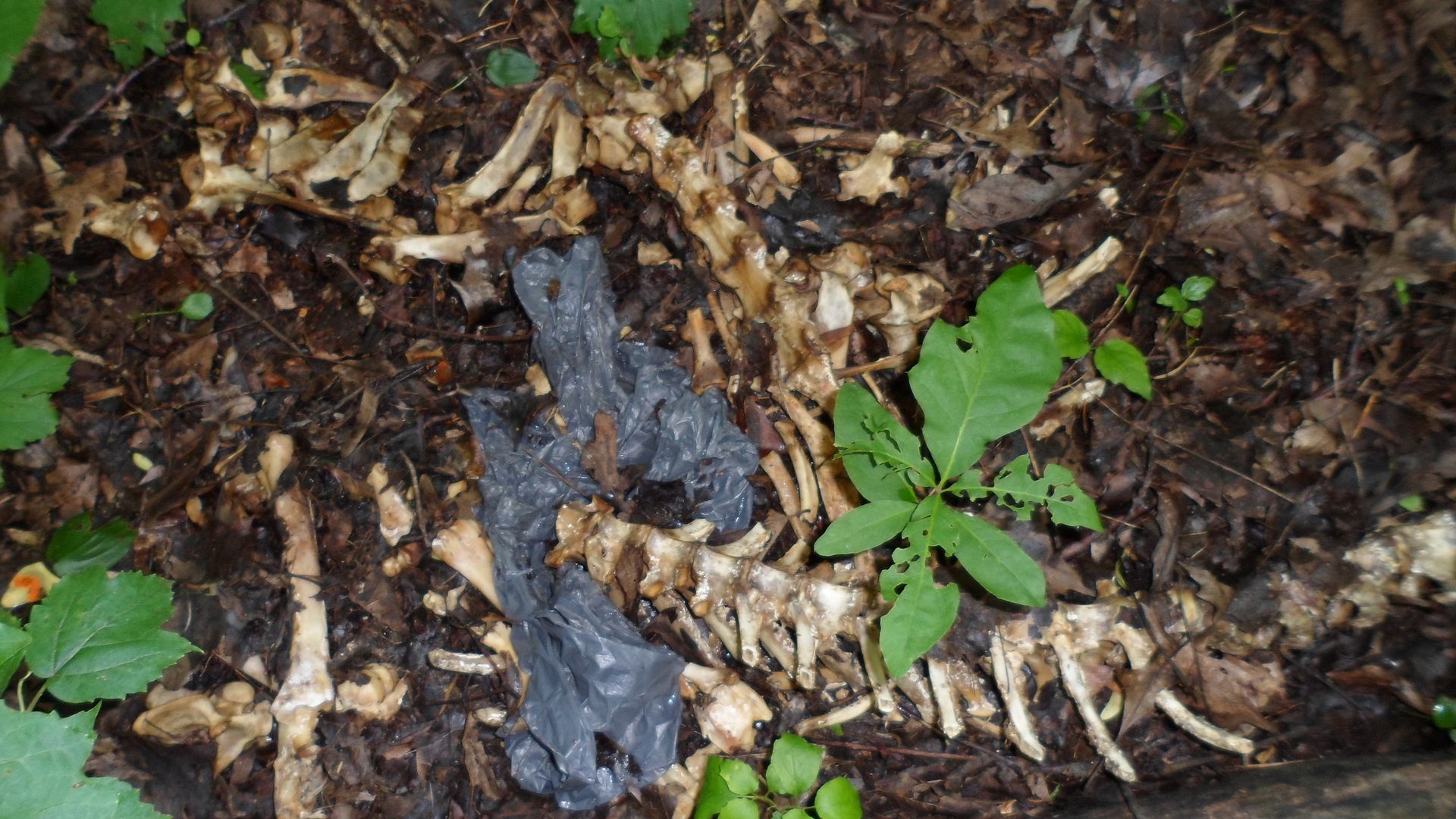
This one was processed for its meat, although something has gone and dragged off the head. The long bones are sawed off and the ribs were cut close to the spine to allow the meat underneath to be removed.

Sawed-off ribs. It's very cool to see the vertebrae still articulated.
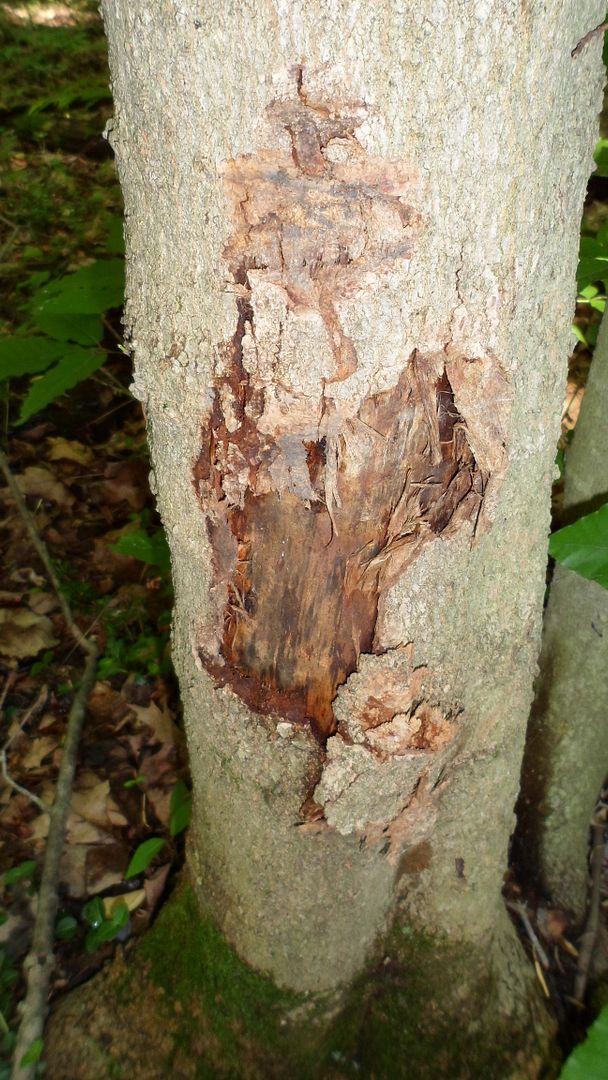
Porcupine? Woodpecker? Nope. This is one of the places on the truck trail where the wood truck (a dilapidated but remarkably functional pickup truck whose doors do not shut and whose dashboard is often inhabited by hornets) has to make a rather sharp turn. The truck, although it runs amazingly well, does not happen to have fully functional brakes. So in order to make the turn, it is necessary to run into this tree to stop, reverse and turn, and then continue on. While running into a tree is not the BEST way to stop, we are never traveling above first or second gear and never at any high speed.
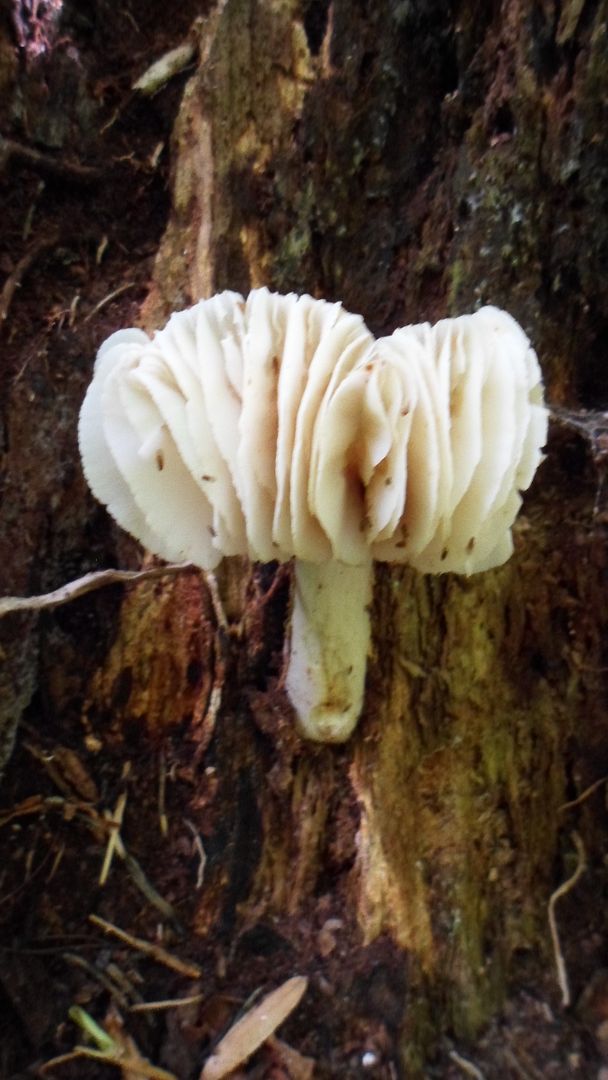
This mushroom, growing inside the cavity of a hollowed-out stump, has curled up to allow for the last of its spores to be freed, spreading the gills as wide as possible. Although this is a generalization and NOT always true, most gilled mushrooms growing on trees have a stalk, and most polypores (tiny holes instead of gills) do not. All ground-growing mushrooms with spores on the underside need a stalk to lift them high enough for the spores to escape, but some have spores dispersed from the upper surface and can be flat.
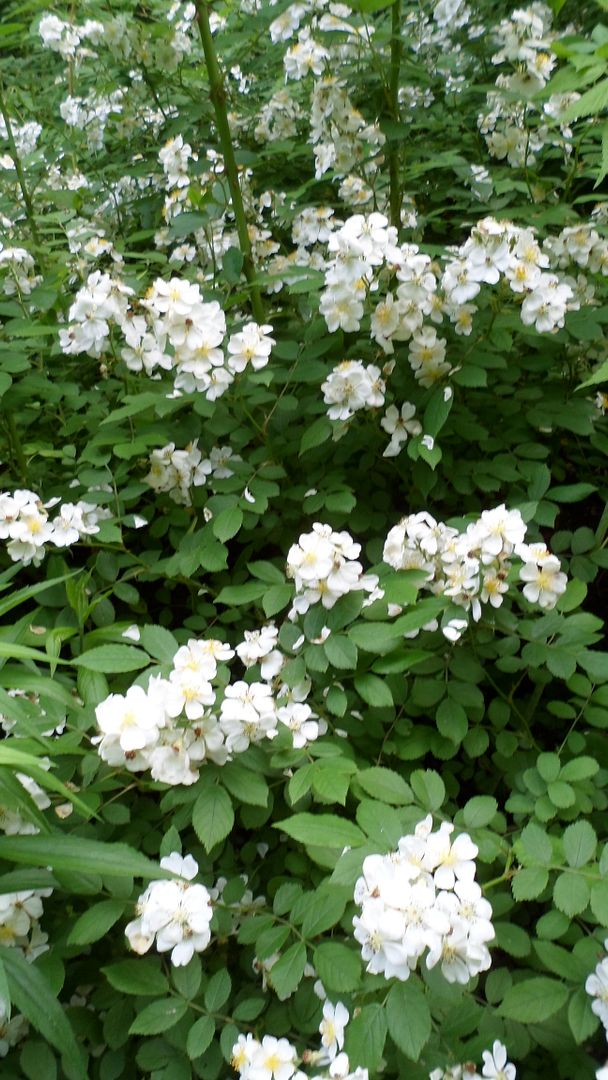
Pretty pretty pretty multiflora roses... their smell this time of year is unspeakably beautiful. Not the heavy, cloying scent of garden roses, although it has traces of the classic rose fragrance mixed with almost fruit-like wildflower freshness that I love more than any rose perfume I could imagine. They are VERY fragrant and walking past a bush will fill the air around you with the beautiful sweet, floral, spring-fresh smell.
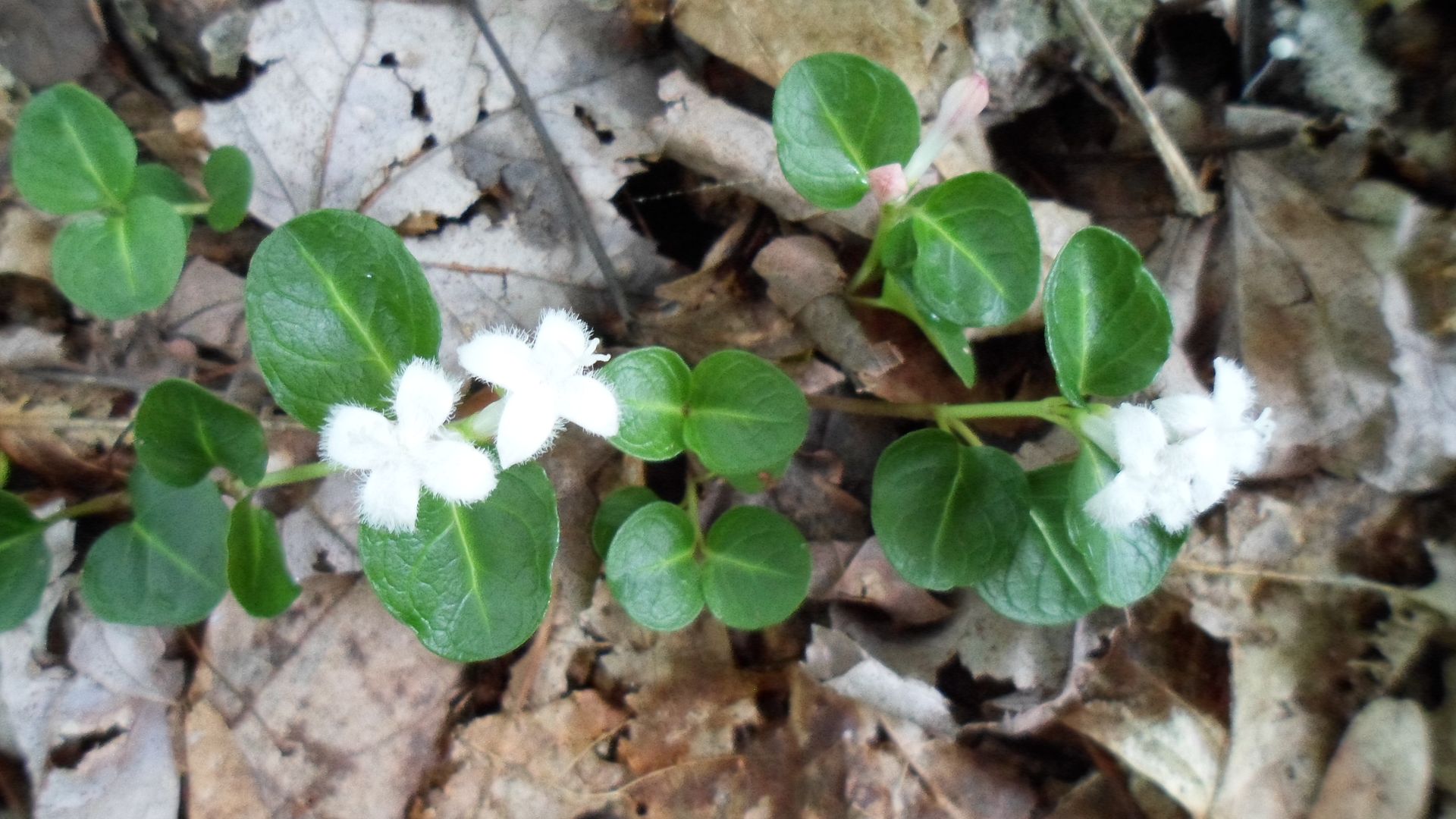
Tiny, white, FUZZY flowers? The paired leaves on the low-growing vine-like stems looked familiar. And after looking it up I knew exactly why... this is my old friend squaw berry/partridge berry/other common name. I am used to seeing it the way it looks from late June through most of the rest of the year, with tiny red berries on it. The berries are actually DOUBLE berries... you can see these flowers are in pairs, and the ovaries of the two flowers will fuse to make conjoined-twin berries. It's exciting to find a familiar plant wearing unfamiliar flowers... sort of like running into someone you see at the gym every week at an event where they're wearing an evening gown.
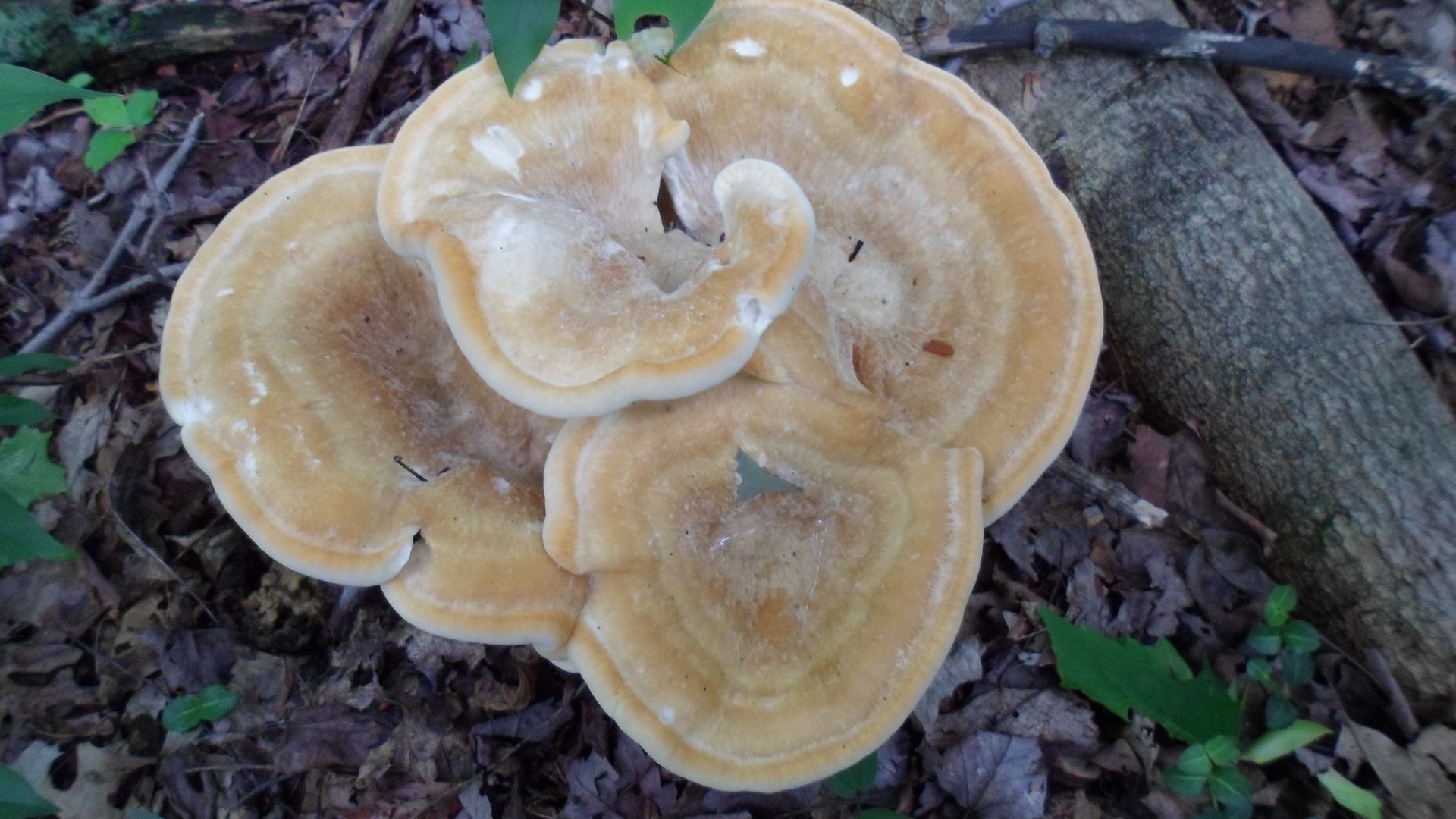
After my fungus failures for the day, discovering this RIGHT BEHIND MY HOUSE was extremely exciting and required a photo shoot worthy of a magazine cover (I have no idea what it is).
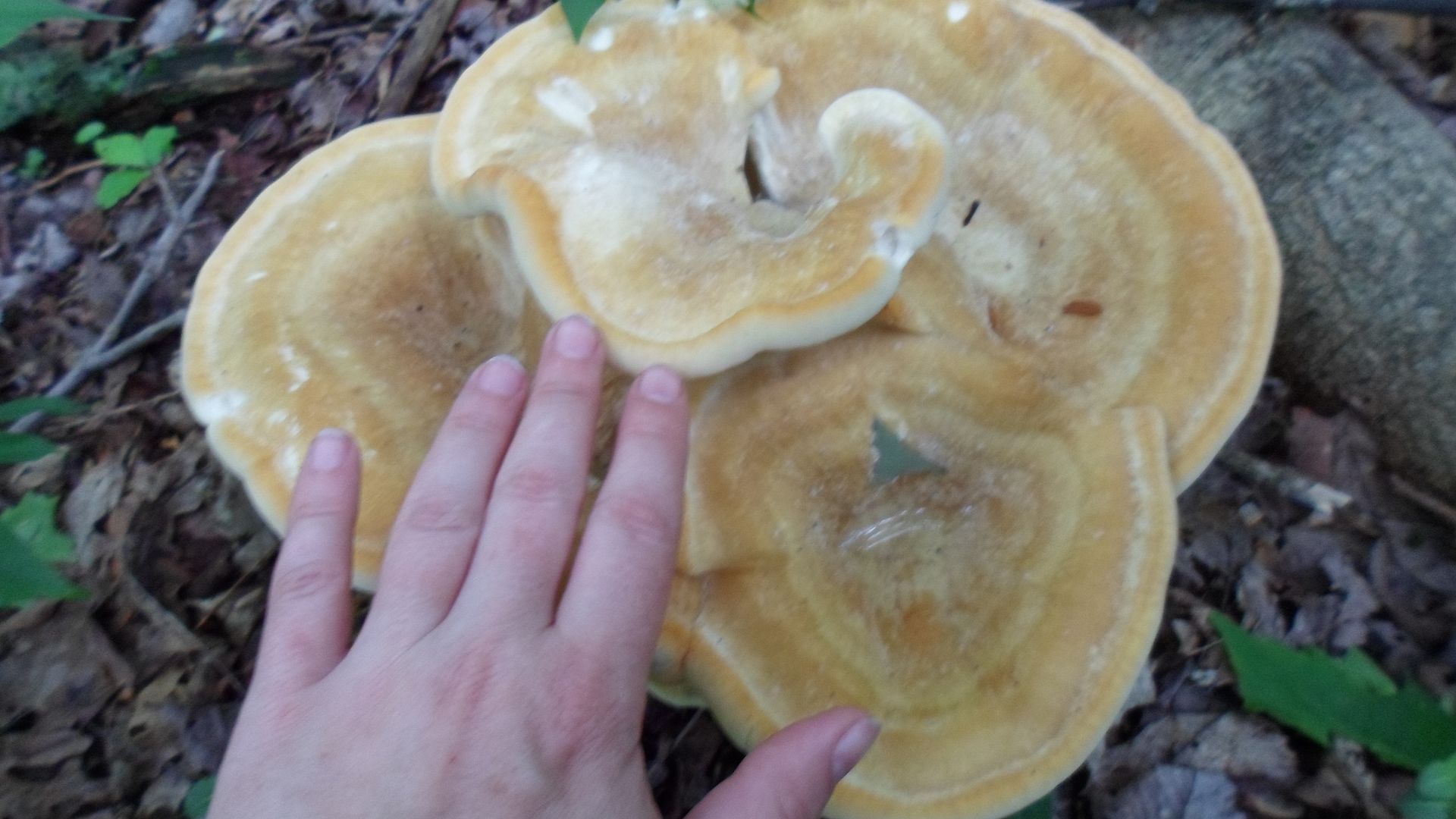
Whatever it is, these fruiting bodies are quite large...
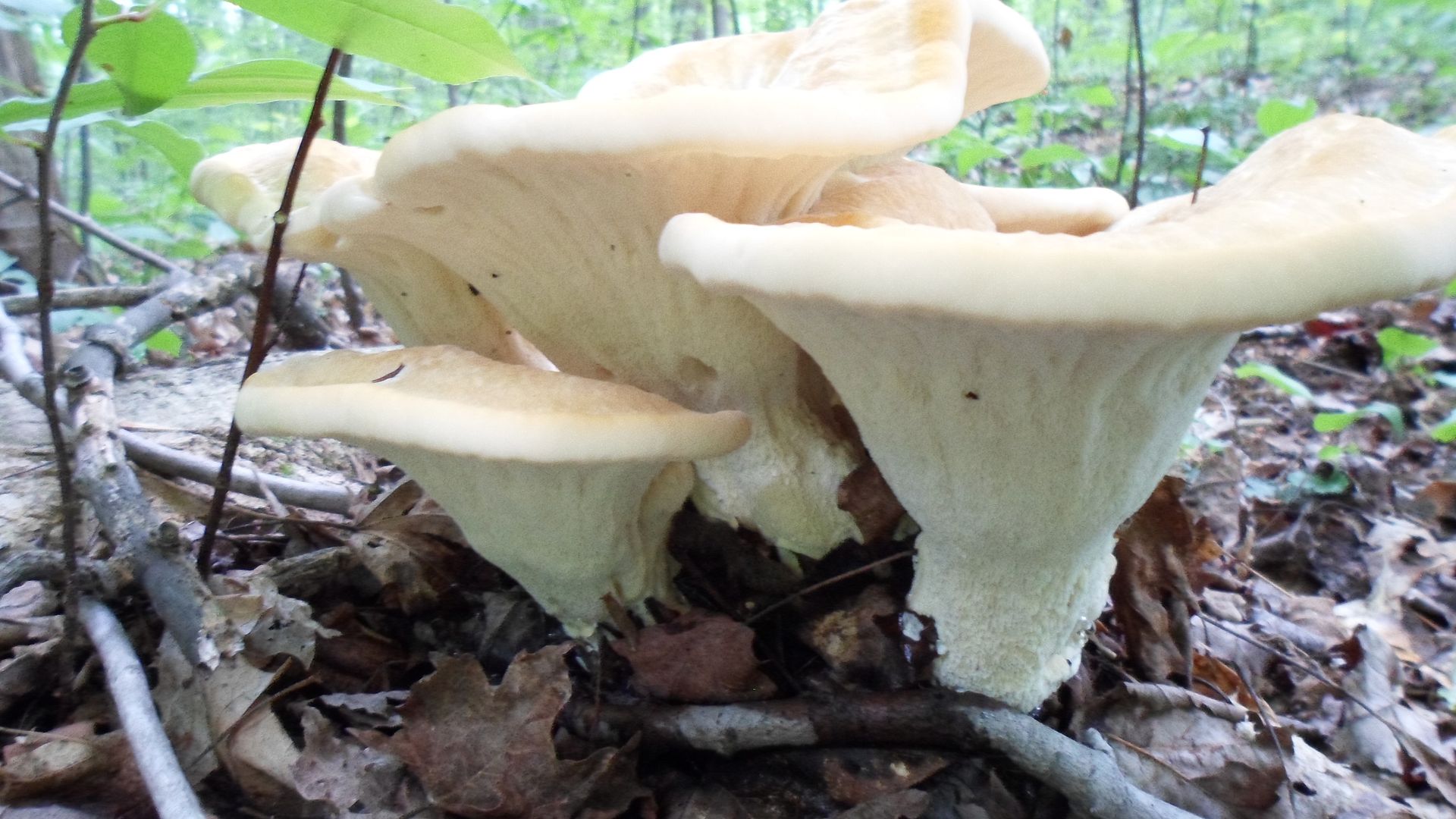
They do not appear to be a gilled mushroom, or if they are the gills are so shallow as to be nearly invisible. The upward-curved shape might make them relatives of the chanterelles although they are definitely NOT chanterelles themselves. Still, they are big and gorgeous and amazing and so lovely with their undersides on display and their pretty cream colors...
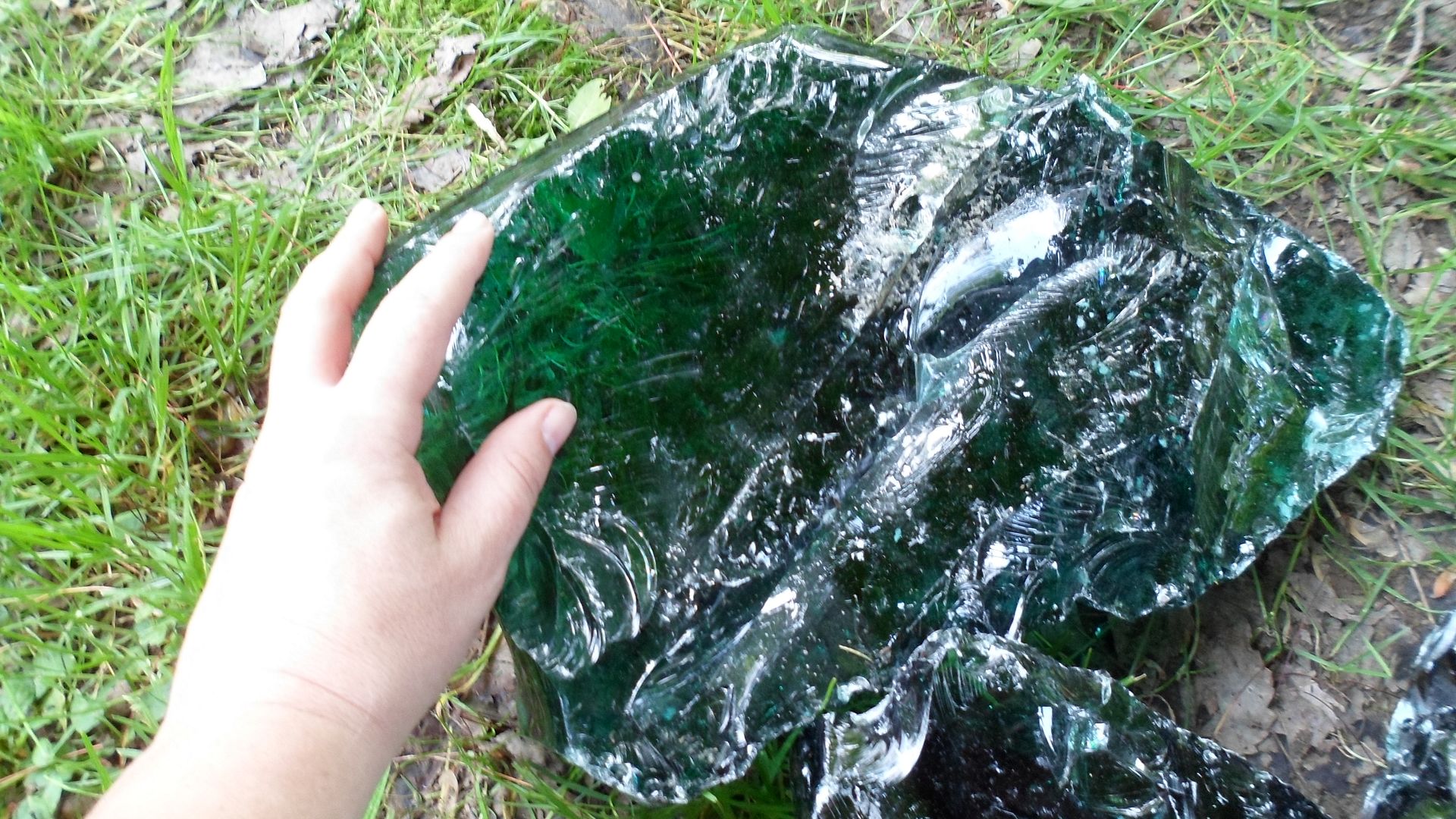
If anyone needs a very large piece of glass, this is what they are jackhammering out of the furnace at my husband's work. The factory has two furnaces and every ten to fifteen years they need to be rebuilt, since no repairs can ever be made to the inside of the furnace... once it's hot, it's never cooled (because if it is you have to jackhammer out glass ten feet deep out of a tank the size of a gymnasium), and there is no repairing the inside of a furnace that is permanently kept at the temperature of liquid glass. Also liquid tin... the best way to get flawless glass (this is automobile window glass, which is always slightly tinted green although you can't tell) is to float it on a tin bath, because the surface of the liquid tin is flawlessly smooth and will not react with glass. So anyway, they are hammering out these huge chunks, so we have a few.

This is what color your car windows actually are. You just don't know it because they're very thin.

Not a wildflower, for sure... the peony is a very highly modified flower which has experienced endless amounts of human intervention to produce blossoms so large and dramatic that they can't even hold themselves upright. Generations of breeding have doubled and tripled and quadrupled the number of petals until the flower heads are these huge, impressive garden beauties, but there's not much natural about them. WIld peonies look like regular flowers and have one set of petals around the usual central arrangement.
And, waiting for me to return...
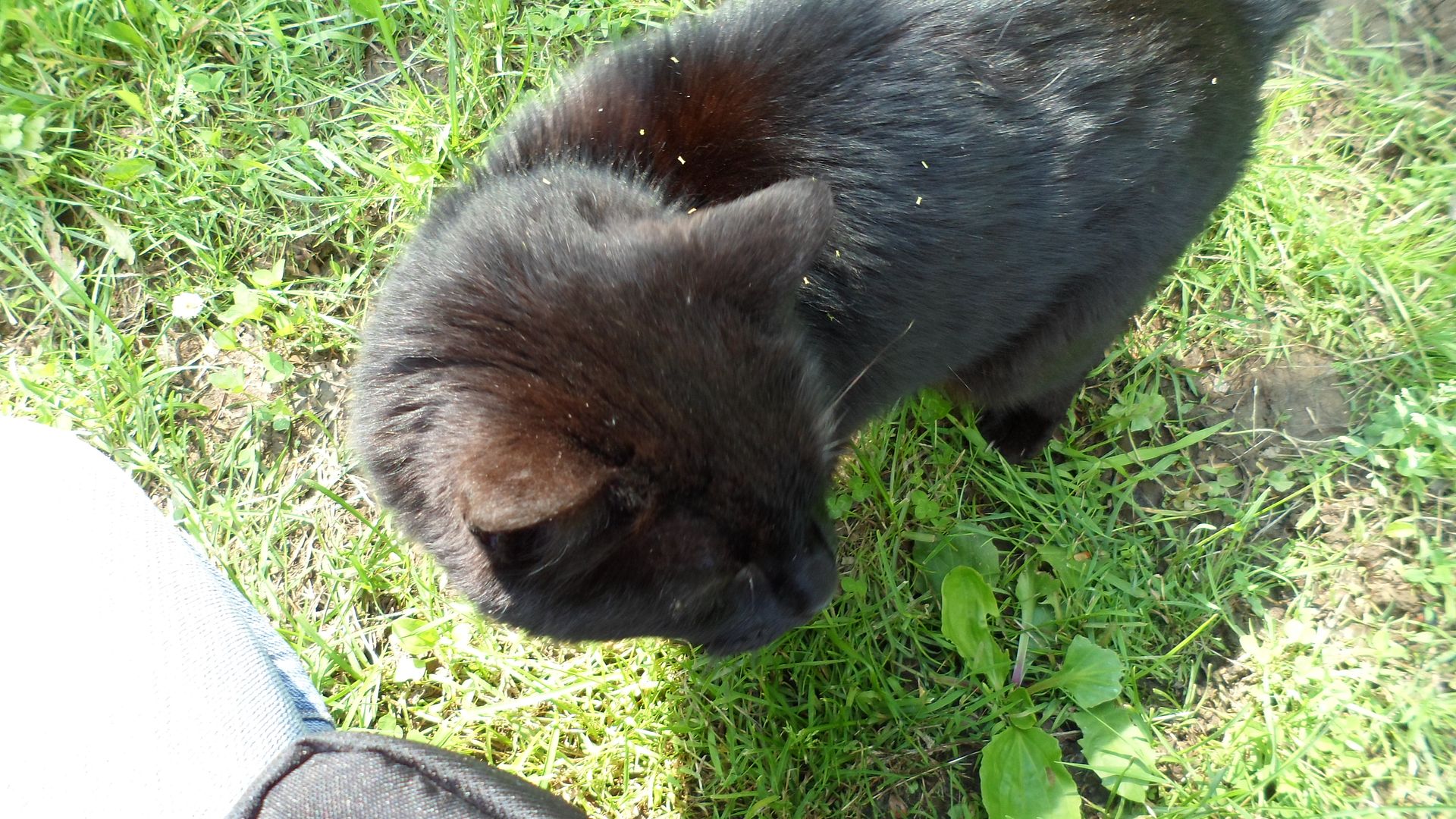
A lazy old Boo-cat wandering around in the sun and following me around the yard (he never leaves the yard).
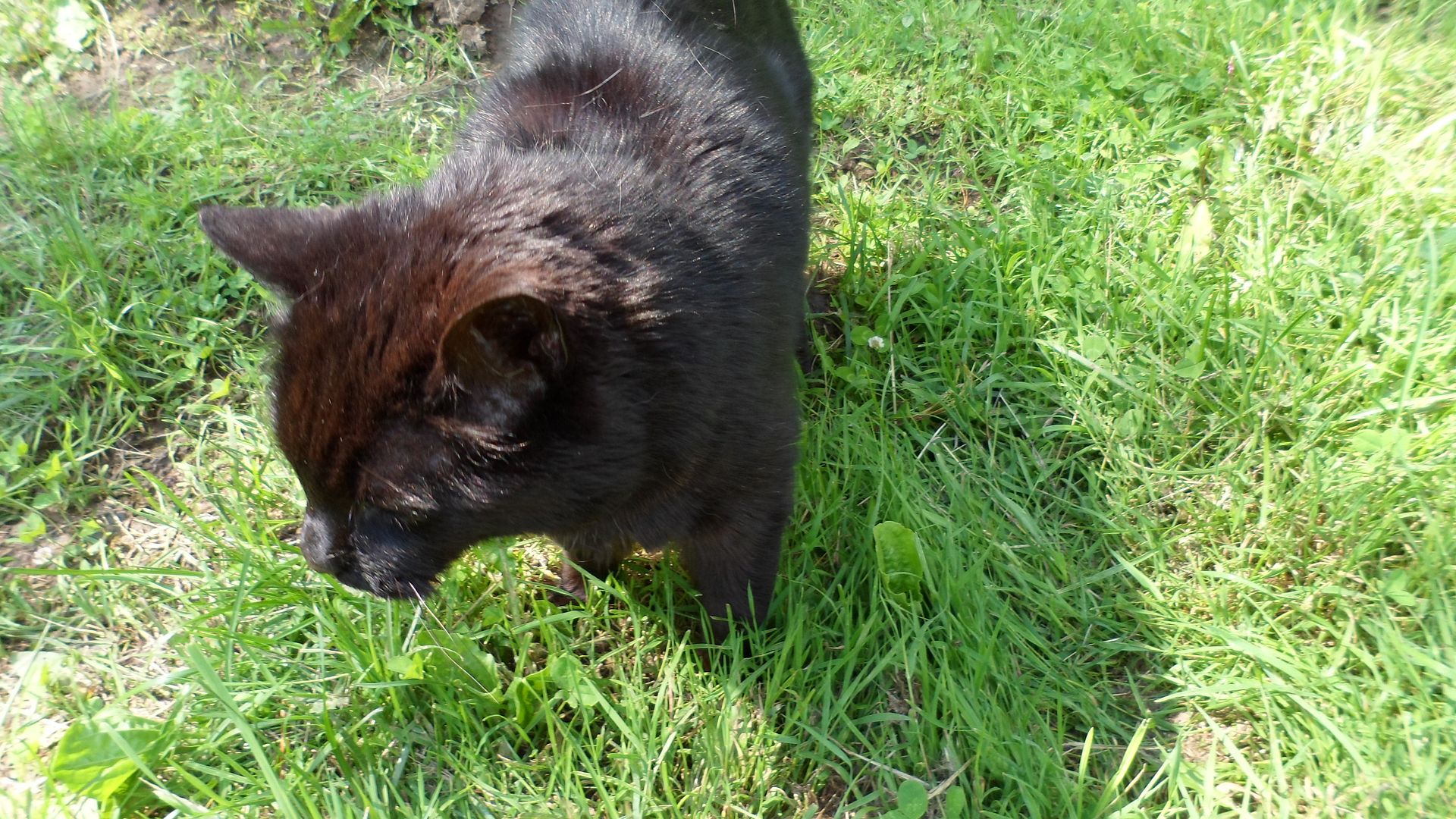
He's looking his age, a bit, but he still seems to have no trouble catching mice (he's never been a birder). His greatest joy in life is following my husband around the yard and laying on the lawnmowers while he fixes them.
.
.
.
ANYWAY.
I did not see the bear today, although he was out dumpster-diving yesterday.
I think I DID, however, solve the mystery of this bizarre flower-looking fungus...

While it's a shame I didn't get a better picture, I believe it's a very young Grifola frondosa. My European friends would not recognize them because they are native only to parts of the USA and to Japan, where they are called maitake. I think the reason I've never found one before is the same reason I never find any morels or chanterelles... this is a very highly desirable edible mushroom and is considered to have medicinal properties. It can get very large and can be sold for a decent bit of cash. I suspect mushroom hunters are active in the state park area around the lake and harvest most of the edibles before I get to see them. I don't think mushroom hunting on state park land is illegal, but even if it was no one would bother to stop them.
I returned today and found it looking like this.

I am not at all certain of this identification but it was the only thing even remotely similar that I found. To be that white and delicate it would have to be a very young one, and it looks like flies and high humidity did it in before it could get any bigger.
ANYWAY.

Meandering around the lake... some more beautiful blue irises/flags/whatever you prefer to call them. The blue ones seem particularly tolerant of wet places... they may be a subspecies or slightly different species from the ones you see in gardens and roadsides.

Narrow-leaf plantain, Plantago lanceolata, an invasive weed from our English settlers, exceedingly common and so familiar almost no one would believe you if you told them it didn't belong here. I like them... they don't really seem to do any harm and their little flower heads are fascinating. The flowers bloom starting at the bottom and moving to the top, and are wind-pollinated, so their habit of not blooming all at once may be an adaptation to avoid self-pollination (some plants are quite happy to self-pollinate but most have some mechanism to avoid it if possible as it lowers genetic diversity).

Some more of those lovely white campions from the other post, the ones that apparently in England are known for growing around gravestones. These ones are growing in a partly-shaded patch, which is why they are only partly open (in unsuitable weather they will close up completely).

Yarrow is well-known to many people as a medicinal herb or just a pretty wildflower. This is the first one I've seen this year. And only the one feathery leaf belongs to the yarrow... the compound pinnate leaves (well, that's what they're called!) belong to crown vetch.

The mountain laurels are blooming! These are among my favorite early season flowers... the markings inside are stunningly beautiful, although only noticeable if you look closely. They are beautiful enough to make them the official flower of several states/provinces. The markings are a guide for pollinators, important because the flowers are not long-lasting and in cold climates where they like to grow, bees can still be a bit lazy this time of year.

Beautiful, beautiful clusters of flowers on all the mountain laurels. I don't notice much of a fragrance, but their relatives such as rhododendrons don't have a strong scent either, and may rely on markings or bold colors (or being the only things around and blooming for hungry bees).

Finally found an intact (if slightly damaged) tulip tree flower for you. Considering how far it fell (I couldn't even SEE the tree it fell from, because it was so much taller than its neighbors), it's impressive to find one that's not in pieces. It is a bit faded; the "petals" (not really, but whatever) are usually greener. Despite not having proper petals, it has all the equipment a flower usually has. The rounded spike in the center will become covered with seeds that develop at the base of a thin sort of wing that helps them disperse from the parent tree; the end result looks something like a soft and very compact pine cone. SOMETHING collects them and makes huge piles of them in our woods but we cannot figure out what is doing it.

Wandering off the trail I found this pretty shoreline...

And this tiny mini-beach all to myself. Unfortunately I had to share it with several VERY dead fish and decided not to stay.

In the unpleasant-spiky-things category, this is Carex lurida, also known as shallow sedge and leave-it-the-hell-alone. It's actually not as nasty as it looks. There are lots of sedges but this one likes muddy or boggy shorelines.
Just when I had given up all hope of finding mushrooms... even my best and most reliable locations had given me nothing... I found this one, which someone or something had VERY recently knocked over...

I love mushroom gills. They are amazingly perfect and organized... the spacing has to be very exact to allow for maximum spore dispersal, since the spores develop on the surface of the gills.

Since it looked very, very fresh and NOT covered with maggots, I picked it up... and lo and behold, the season's first fly agaric, and a stunningly beautiful one (the yellow color morph is much more common here than the red one of classic fairy tale mushrooms). It can't have been on the ground longer than a few hours, to still look so fresh. The upper surface had a slightly tacky texture, like half-dry paint, but a bit more slippery. The bits stuck all over it are remnants of the veil it hid in as a little budding mushroom underground.

Unlike the texture of the top, the gills are amazingly soft, almost buttery soft, and feel like velvet brushed against your hand. If you could look very closely, you would see clusters of microscopic spores developing and then falling free (often weighed down by a micro-droplet of water). The gills are perfectly designed to allow the spores to fall freely. Touching them is almost hypnotic and I could have spent an hour sitting and brushing my fingers over them, the amazing softness and delicate ripples beneath my fingertips. However, since this species is poisonous (not terribly so, but enough to make you feel sick and enough not to want to eat it or probably rub it all over yourself and then accidentally get it in your mouth, so I reluctantly decided to stop petting it.
Back on home turf...

I've shown you pictures of the completely barren, muddy, flattened area where the beaver pond was... but before the beavers built THAT pond, they had another one, farther downstream. This is the floodplain of THAT beaver dam, many years older and with time to regrow its grassy swamp flora, although it's still studded with dead trees that did not appreciate suddently finding themselves in the middle of a pond. Because they were several feet underwater, they were not immediately attacked by fungi and some of them still seem to be ignored.

This is probably what the current barren-looking mess of the recently emptied beaver pond will look like in ten years or so... lush growth that tolerates the swampy ground cut through with endless tiny runoff creeks, dead trees standing as reminders of the past, new saplings testing their feet in the still-unstable ground which is made up of the muddy silt that accumulated at the bottom of this former pond.

Some bits from a deer that I found near the mud... these could be from a natural death instead of from one hunted and processed for food... when they butcher the deer for meat there is usually some sawing through the long bones of the legs since they have basically no meat on them whatsoever and get in the way of the rest of the work. These ones have no cut ends and no knife marks.

This one was processed for its meat, although something has gone and dragged off the head. The long bones are sawed off and the ribs were cut close to the spine to allow the meat underneath to be removed.

Sawed-off ribs. It's very cool to see the vertebrae still articulated.

Porcupine? Woodpecker? Nope. This is one of the places on the truck trail where the wood truck (a dilapidated but remarkably functional pickup truck whose doors do not shut and whose dashboard is often inhabited by hornets) has to make a rather sharp turn. The truck, although it runs amazingly well, does not happen to have fully functional brakes. So in order to make the turn, it is necessary to run into this tree to stop, reverse and turn, and then continue on. While running into a tree is not the BEST way to stop, we are never traveling above first or second gear and never at any high speed.

This mushroom, growing inside the cavity of a hollowed-out stump, has curled up to allow for the last of its spores to be freed, spreading the gills as wide as possible. Although this is a generalization and NOT always true, most gilled mushrooms growing on trees have a stalk, and most polypores (tiny holes instead of gills) do not. All ground-growing mushrooms with spores on the underside need a stalk to lift them high enough for the spores to escape, but some have spores dispersed from the upper surface and can be flat.

Pretty pretty pretty multiflora roses... their smell this time of year is unspeakably beautiful. Not the heavy, cloying scent of garden roses, although it has traces of the classic rose fragrance mixed with almost fruit-like wildflower freshness that I love more than any rose perfume I could imagine. They are VERY fragrant and walking past a bush will fill the air around you with the beautiful sweet, floral, spring-fresh smell.

Tiny, white, FUZZY flowers? The paired leaves on the low-growing vine-like stems looked familiar. And after looking it up I knew exactly why... this is my old friend squaw berry/partridge berry/other common name. I am used to seeing it the way it looks from late June through most of the rest of the year, with tiny red berries on it. The berries are actually DOUBLE berries... you can see these flowers are in pairs, and the ovaries of the two flowers will fuse to make conjoined-twin berries. It's exciting to find a familiar plant wearing unfamiliar flowers... sort of like running into someone you see at the gym every week at an event where they're wearing an evening gown.

After my fungus failures for the day, discovering this RIGHT BEHIND MY HOUSE was extremely exciting and required a photo shoot worthy of a magazine cover (I have no idea what it is).

Whatever it is, these fruiting bodies are quite large...

They do not appear to be a gilled mushroom, or if they are the gills are so shallow as to be nearly invisible. The upward-curved shape might make them relatives of the chanterelles although they are definitely NOT chanterelles themselves. Still, they are big and gorgeous and amazing and so lovely with their undersides on display and their pretty cream colors...

If anyone needs a very large piece of glass, this is what they are jackhammering out of the furnace at my husband's work. The factory has two furnaces and every ten to fifteen years they need to be rebuilt, since no repairs can ever be made to the inside of the furnace... once it's hot, it's never cooled (because if it is you have to jackhammer out glass ten feet deep out of a tank the size of a gymnasium), and there is no repairing the inside of a furnace that is permanently kept at the temperature of liquid glass. Also liquid tin... the best way to get flawless glass (this is automobile window glass, which is always slightly tinted green although you can't tell) is to float it on a tin bath, because the surface of the liquid tin is flawlessly smooth and will not react with glass. So anyway, they are hammering out these huge chunks, so we have a few.

This is what color your car windows actually are. You just don't know it because they're very thin.

Not a wildflower, for sure... the peony is a very highly modified flower which has experienced endless amounts of human intervention to produce blossoms so large and dramatic that they can't even hold themselves upright. Generations of breeding have doubled and tripled and quadrupled the number of petals until the flower heads are these huge, impressive garden beauties, but there's not much natural about them. WIld peonies look like regular flowers and have one set of petals around the usual central arrangement.
And, waiting for me to return...

A lazy old Boo-cat wandering around in the sun and following me around the yard (he never leaves the yard).

He's looking his age, a bit, but he still seems to have no trouble catching mice (he's never been a birder). His greatest joy in life is following my husband around the yard and laying on the lawnmowers while he fixes them.
.
.
.